- Sustainable
- Energy Economy
- Energy Services


What is Round Trip Efficiency?
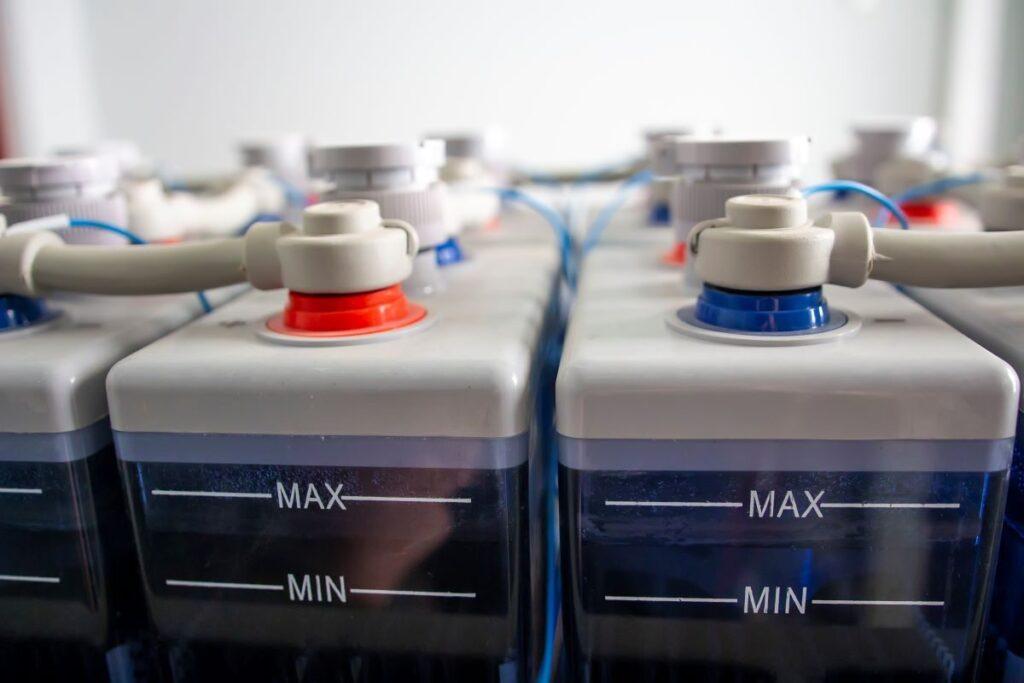
Energy storage systems function by taking in electricity, storing it, and subsequently returning it to the grid. The round trip efficiency (RTE), also known as AC/AC efficiency, refers to the ratio between the energy supplied to the storage system (measured in MWh) and the energy retrieved from it (also measured in MWh). This efficiency is expressed as a percentage (%).
The round trip efficiency is a crucial factor in determining the effectiveness of storage technology. A higher RTE indicates that there is less energy loss during the storage process, resulting in a more efficient overall system. Grid systems engineers strive for energy storage systems to achieve an 80% RTE whenever feasible, as it signifies a desirable level of efficiency and minimizes energy losses.
What Factors Can Affect the Round Trip Efficiency of an Energy Storage System?
The RTE of an energy storage system can be influenced by various factors, including:
1. Technology: Different storage technologies have varying round-trip efficiencies. For example, hydro storage typically ranges from 65% in older installations to 75-80% in modern deployments, while flywheels have efficiencies of about 80% to 90%. Some battery technologies can have round-trip efficiencies ranging from 75% to 90%.
2. Storage duration: Some technologies may experience leakage or energy loss over long-term storage, which can affect round-trip efficiency. It is important to consider the specific characteristics and limitations of the storage technology when evaluating its efficiency.
3. Age and condition of the system: Older storage systems may have lower round-trip efficiencies compared to newer ones. Factors such as wear and tear, component degradation, and maintenance practices can impact the overall efficiency of the system.
4. Charging and discharging rates: The speed at which energy is charged into and discharged from the storage system can affect its efficiency. Certain technologies may have lower efficiencies at high charging or discharging rates.
5. System design and control: The design and control strategies implemented in the energy storage system can influence its round-trip efficiency. Optimal system design, efficient power electronics, and effective control algorithms can improve the overall efficiency of the system.
6. Temperature: Temperature can have an impact on the performance and efficiency of energy storage systems. Extreme temperatures can affect the efficiency of certain storage technologies, such as batteries, leading to lower round-trip efficiencies.
Considering these factors is crucial when evaluating the round-trip efficiency of an energy storage system, as they can significantly affect its performance and effectiveness in storing and retrieving energy.
Must Read: What is Power Conversion Efficiency?

Elliot is a passionate environmentalist and blogger who has dedicated his life to spreading awareness about conservation, green energy, and renewable energy. With a background in environmental science, he has a deep understanding of the issues facing our planet and is committed to educating others on how they can make a difference.
Related Posts

What is Post-Consumer Recycled (PCR) Content?

What is Heating Seasonal Performance Factor (HSPF)?

What is Annual Fuel Utilization Efficiency (AFUE)?
Save my name, email, and website in this browser for the next time I comment.
Type above and press Enter to search. Press Esc to cancel.

Today in Energy
- Recent articles
- liquid fuels
- natural gas
- electricity
- oil/petroleum
- production/supply
- consumption/demand
- exports/imports
- international
- forecasts/projections
- steo (short-term energy outlook)
Utility-scale batteries and pumped storage return about 80% of the electricity they store
Electric energy storage is becoming more important to the energy industry as the share of intermittent generating technologies, such as wind and solar, in the electricity mix increases. Electric energy storage helps to meet fluctuating demand, which is why it is often paired with intermittent sources. Storage technologies include batteries and pumped-storage hydropower , which capture energy and store it for later use. Storage metrics can help us understand the value of the technology. Round-trip efficiency is the percentage of electricity put into storage that is later retrieved. The higher the round-trip efficiency, the less energy is lost in the storage process. According to data from the U.S. Energy Information Administration (EIA), in 2019, the U.S. utility-scale battery fleet operated with an average monthly round-trip efficiency of 82%, and pumped-storage facilities operated with an average monthly round-trip efficiency of 79%.
EIA’s Power Plant Operations Report provides data on utility-scale energy storage, including the monthly electricity consumption and gross electric generation of energy storage assets, which can be used to calculate round-trip efficiency. The metrics reviewed here use the finalized data from the Power Plant Operations Report for 2019—the most recent year for which a full set of storage data is available.
Pumped-storage facilities are the largest energy storage resource in the United States. The facilities collectively account for 21.9 gigawatts (GW) of capacity and for 92% of the country’s total energy storage capacity as of November 2020.
In recent years, utility-scale battery capacity has grown rapidly as battery costs have decreased. As batteries have been increasingly paired with renewables , they have become the second-largest source of electricity storage. As of November 20, 2020, utility-scale battery capacity had 1.4 GW of operational capacity. Another 4.0 GW of battery capacity is scheduled to come online in 2021, according to EIA’s Preliminary Electric Generator Inventory .
Although battery storage has slightly higher round-trip efficiency than pumped storage, pumped-storage facilities typically operate at utilization factors that are currently twice as high as batteries. Increasing durations among battery applications could shift battery operations toward services that reward longer output periods. For example, in 2015, the weighted average battery duration was a little more than 46 minutes, but by 2019, weighted average battery durations had doubled to 1.5 hours. The role of batteries and their capability to provide high levels of round-trip efficiency may become more important as batteries continue to be deployed and as the intermittent renewables share of the electricity mix grows.
Tags: storage , electricity
This is the UK domain, to see the EU or other regions, please click below
- Visit the GivEnergy cloud

- All in One – battery plus inverter
- AC coupled inverter
- Hybrid inverter
- Battery storage
- Full energy ecosystem overview
- Start your journey
- Commercial All in One
- Power conversion system (PCS)
- Battery packs
- Commercial battery rack
- SME battery system
- Battery storage container
Energy management software
- GivEnergy app
- GivEnergy portal
- GivEngineer – installer commissioning app
- Home battery storage
- Commercial battery storage
- Sustainable construction projects
- Social housing project
- Wholesalers
- Energy suppliers – E.ON partner
- Energy suppliers – Octopus
- Energy aggregators
- Solar industry – Open Solar
- Solar industry – Easy PV
- Giv-Gallery
- Case studies
- Support hall of fame
- Why choose GivEnergy?
- Refer a friend
- Find a distributor
- Knowledge base
- Community forum
Documentation
- Resource hub
- Domestic product brochure 2024
- Commercial product brochure 2024
- GivEnergy API
- Server status
- View all posts

3 biggest threats to our electricity supply (& how battery...

[PRODUCT UPDATE] We’re opening the beta on parallel All in...

Are GivEnergy batteries compatible with third-party kit?
- FIND AN INSTALLER
- Home-owners

- January 30, 2024
- Blog , Commercial battery storage , Domestic battery storage , Explain like I’m 5
What is round trip efficiency in battery storage?
Round trip efficiency (RTE) is a measure of how efficiently a battery can store and discharge energy. Find out why it’s crucial in the world of BESS.
Terminology in the world of battery storage can seem daunting to the average Joe.

Luckily, we’re here to help.
Round trip efficiency (RTE) is something you may have come across in relation to batteries.
In a nutshell, RTE measures how efficiently a battery can store and discharge energy.
How is RTE calculated? Why are there no batteries with 100% RTE? How has RTE in storage batteries improved in recent years?
Read on to find the answers to these questions.
How to calculate the RTE of a battery?
The RTE of a battery can be calculated as a percentage using a simple formula shown below:
Energy output ÷ energy input x 100 = RTE
Let’s demonstrate what this means in practical terms with an example.
Mrs Jones installs a storage battery for her home . As she and her family typically use 10 kWh of electricity per day, she opts for a 10 kWh storage battery.
As someone who is both eco-conscious and has an above-average income, Mrs Jones installs both solar panels and a wind turbine to power her battery storage system. This means she can charge her 10 kWh battery from renewable sources.

However, Mrs Jones soon realises that she isn’t getting 10 kWh per day from her storage battery.
In reality, she gets 8 kWh per day. That’s because her 10 kWh battery has 80% round trip efficiency.
If she had opted for a 10 kWh battery with 90% round trip efficiency, she would get… yep… 9 kWh per day.
For her remaining 2 kWh per day of electricity needs, she draws energy from the grid.
Why do batteries lose energy?
Unfortunately, batteries always lose a small amount of energy during operation.
This is usually because of heat loss, self-discharge, high internal cell resistance or other factors.
Are there any batteries with 100% RTE?
You can think of it like this: if anyone ever tries to sell you a 100% RTE battery, run a mile because they’re almost certainly lying.
What is the RTE of a typical battery?
RTE varies among different types of storage batteries .

For older battery systems, 80% round trip efficiency would have been considered a good standard. Some evidence suggests the typical lithium-ion battery – a popular choice for modern battery energy storage systems and electric vehicles – has round trip efficiency of around 83%.
GivEnergy’s own batteries – using LiFePO4 (lithium iron phosphate) – have achieved 93% round trip efficiency .
RTE – not to be ignored
Grid-level battery storage is becoming increasingly common to accommodate the growth in renewables, especially solar and wind.

Round trip efficiency is a factor that decision-makers need to take into account when assessing the overall efficiency of an energy storage system.
And it’s something YOU also need to bear in mind when installing your own battery storage system for your home or business.
Remember: 100% round trip efficiency is a lie! However, 93% round trip efficiency with a GivEnergy battery using LiFePO4 technology is not a lie.
Looking to play your part in the energy storage revolution? Get started by finding an approved GivEnergy installer today.
Further reading
- Explain like I’m 5: depth of discharge
- LiFePO4 battery: what is it & why is it best for BESS?
- The superior choice: embracing LiFePO4 batteries over NMC technology

Quick Links
Getting started with...

Product images used are for illustrative purposes. The finished setup will vary from installation to installation, and will include all your needed cable connections, metering, any (outdoor) canopies, etc.
Performance Analysis of Lithium-Ion Battery Considering Round Trip Efficiency
Ieee account.
- Change Username/Password
- Update Address
Purchase Details
- Payment Options
- Order History
- View Purchased Documents
Profile Information
- Communications Preferences
- Profession and Education
- Technical Interests
- US & Canada: +1 800 678 4333
- Worldwide: +1 732 981 0060
- Contact & Support
- About IEEE Xplore
- Accessibility
- Terms of Use
- Nondiscrimination Policy
- Privacy & Opting Out of Cookies
A not-for-profit organization, IEEE is the world's largest technical professional organization dedicated to advancing technology for the benefit of humanity. © Copyright 2024 IEEE - All rights reserved. Use of this web site signifies your agreement to the terms and conditions.

Empowering Innovations: The Bright Future of Round Trip Efficiency of Battery
Round Trip Efficiency of Battery
The concept of round trip efficiency of battery is pivotal in energy storage technologies. This section will provide an extensive introduction to what round trip efficiency means in the context of batteries.
We'll explore its importance in various applications, ranging from small-scale electronics to large-scale energy systems.
Understanding the round trip efficiency of battery is essential for assessing the performance and sustainability of these energy storage devices.

The Science Behind Round Trip Efficiency
Delving deeper into the technicalities, this part will explain how the round trip efficiency of battery is determined. It will cover the fundamental principles of battery operation, including charge and discharge cycles, energy losses during these cycles, and how they affect overall efficiency. Factors like temperature, charge rate, and battery age, which significantly impact round trip efficiency, will be discussed in detail.
Components Affecting Round Trip Efficiency
In this subsection, we will explore the various components of batteries, such as electrodes, electrolytes, separators, and casings, and how each contributes to or detracts from the round trip efficiency. The material composition of these components, their engineering, and how they interact with each other play a critical role in the efficiency of the battery.
The Role of Battery Design
This part will discuss how the physical and chemical design of a battery influences its round trip efficiency. Topics like battery size, shape, internal architecture, and the arrangement of cells within a battery pack will be covered. The section will also explore how innovative design strategies are being employed to enhance efficiency.
Types of Batteries and Their Round Trip Efficiency
This section will provide a comparative analysis of different battery types, such as lithium-ion, lead-acid, and nickel-metal hydride, focusing on their round trip efficiencies. Each battery type's unique characteristics, advantages, and limitations in terms of efficiency will be discussed.
Lithium-Ion Batteries and Efficiency
Focusing on lithium-ion batteries, this subsection will delve into why they are widely regarded for their high round trip efficiency. We will examine the factors that contribute to this efficiency and the challenges that still exist. The latest advancements in lithium-ion technology aimed at improving efficiency will also be highlighted.
Other Battery Technologies
This part will look at alternative battery technologies, comparing their round trip efficiencies with that of lithium-ion batteries. It will cover emerging technologies like solid-state batteries, flow batteries, and others, discussing their potential to rival or surpass the efficiency of traditional battery types
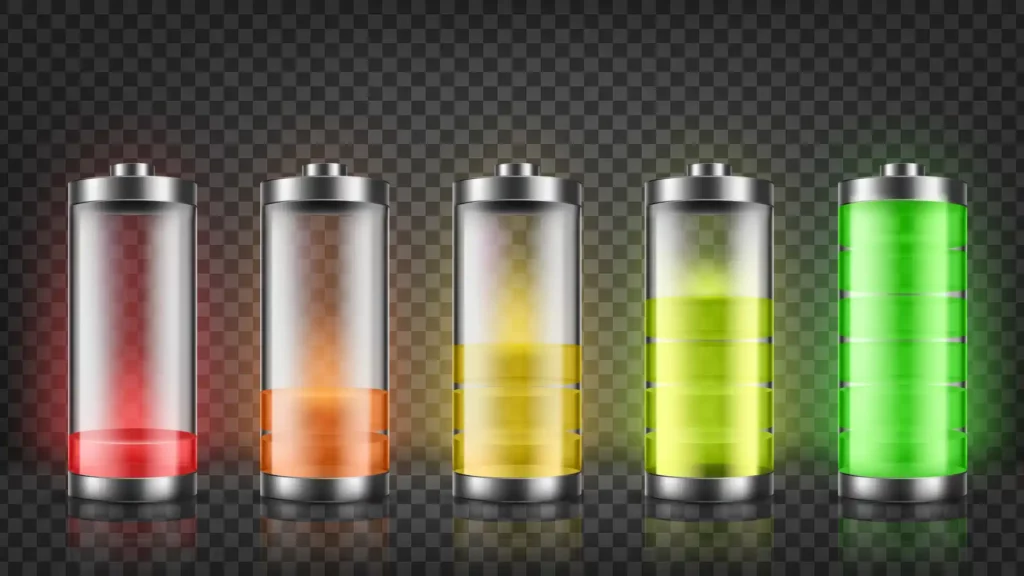
Improving the Round Trip Efficiency of Battery
This section will explore the various strategies and technological advancements aimed at enhancing the round trip efficiency of battery. It will cover research and development efforts in new materials, battery chemistry, and manufacturing techniques. Discussion will include how these advancements could potentially increase efficiency, reduce costs, and extend the life of batteries.
Innovations in Battery Materials
Delving into the realm of materials science, this subsection will explore new and innovative materials being developed to increase the round trip efficiency of battery. This includes advancements in electrode materials, electrolyte formulations, and separator technologies. We'll look at how these new materials can reduce energy losses during charging and discharging, thereby improving overall efficiency.
The Future of Battery Efficiency
In this part, we will explore the cutting-edge research and future directions aimed at pushing the boundaries of round trip efficiency in battery technology. This will include a discussion on potential breakthroughs, the challenges researchers face, and the implications these advancements could have on the global energy landscape.
Applications and Importance of High Round Trip Efficiency
Discussing the wide range of applications where high round trip efficiency in batteries is critical, this section will cover areas like electric vehicles, renewable energy storage, grid management, and consumer electronics. We'll explore how improvements in battery efficiency can impact these fields, leading to more sustainable and efficient energy usage.
Impact on Electric Vehicles
Focusing on electric vehicles (EVs), this subsection will discuss how the round trip efficiency of battery affects the performance, range, and cost-effectiveness of EVs. We'll explore current challenges, the importance of efficiency improvements in the context of EV adoption, and how advancements could shape the future of transportation.
Renewable Energy Storage Systems
In this part, the role of battery efficiency in the effectiveness and viability of renewable energy storage systems will be examined. We'll discuss how higher round trip efficiency can enhance the storage and release of energy from sources like solar and wind, making renewable energy more reliable and accessible.
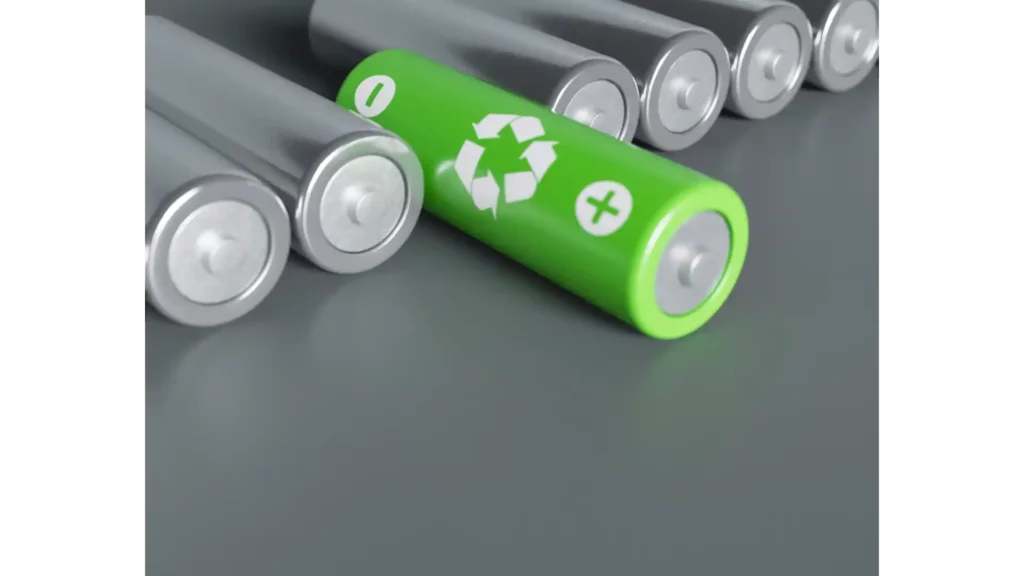
Battery Round Trip Efficiency Definition: Understanding the Concept
The definition of battery round trip efficiency is a fundamental concept in the realm of battery technology and energy storage. This section aims to elucidate the battery round trip efficiency definition and its relevance in practical applications.
Exploring the Battery Round Trip Efficiency Definition
Battery round trip efficiency is defined as the ratio of the energy output of a battery to the energy input required to recharge it. This definition provides a quantitative measure of how effectively a battery stores and then releases the energy put into it. It's a critical parameter for evaluating the performance of a battery, as it directly influences the efficiency and cost-effectiveness of the battery in its practical application.
Implications of Battery Round Trip Efficiency in Energy Systems
Understanding the battery round trip efficiency definition is vital for anyone involved in the design, manufacture, or use of battery systems. This efficiency metric is particularly important in applications where energy conservation and efficiency are paramount, such as in electric vehicles, renewable energy systems, and portable electronic devices. A higher round trip efficiency means more of the stored energy is available for use, which is crucial for the overall efficiency and sustainability of these systems.
Environmental Impact of Battery Efficiency
This new section will explore the environmental implications of the round trip efficiency of battery. It will discuss how increased efficiency can lead to reduced energy waste and lower carbon footprints. This part will also cover the lifecycle of batteries, including manufacturing and recycling processes, and how efficiency plays a role in minimizing environmental impact.
Economic Aspects of Battery Efficiency
In this section, we'll delve into the economic aspects of round trip efficiency in batteries. It will cover how higher efficiency can lead to cost savings for consumers and businesses, and its impact on the overall economy. This part will also discuss the investment in research and development for more efficient batteries and how this drives innovation in the battery industry.
Safety and Reliability Concerns
This part will address how the round trip efficiency of battery relates to their safety and reliability. We'll explore the challenges that arise when trying to balance high efficiency with safety, especially in high-demand applications like electric vehicles and energy storage systems. This section will also discuss the measures taken to ensure that efficiency improvements do not compromise the safety and longevity of batteries.
Regulatory and Policy Frameworks
This new section will examine the role of regulatory and policy frameworks in shaping the development and adoption of efficient battery technologies. It will cover current regulations and standards related to battery efficiency, and how these policies impact the industry. Additionally, this part will discuss potential future policies that could encourage or mandate improvements in battery efficiency.

BatteryRound Trip Efficiency Calculation: Methods and Importance
The calculation of battery round trip efficiency is a critical aspect in assessing the performance of battery systems. This section delves into the methodologies and significance of accurately performing batteryround trip efficiency calculation.
Understanding the Basics of Battery Round Trip Efficiency Calculation
To begin with, battery round trip efficiency calculation involves determining the ratio of the energy outputted by the battery to the energy inputted into it during charging. This calculation is crucial for understanding how much energy is lost in the process of charging and discharging a battery. These energy losses typically occur due to factors like internal resistance, heat generation, and the inefficiencies in the battery's chemical processes.
Step-by-Step Process of Battery Round Trip Efficiency Calculation
To calculate battery round trip efficiency, one must first measure the amount of energy inputted into the battery during the charging process. This is typically done in watt-hours (Wh) or kilowatt-hours (kWh). Following this, the energy outputted by the battery during discharge is measured. The round trip efficiency is then calculated by dividing the energy outputted by the energy inputted and multiplying the result by 100 to obtain a percentage. A higher percentage indicates a more efficient battery with less energy loss.
The Significance of Accurate Calculation
Accurate battery round trip efficiency calculation is crucial for several reasons. Firstly, it allows for the comparison of different battery technologies on a uniform basis, aiding in the selection of the most efficient and suitable battery for a specific application. Secondly, understanding the efficiency of a battery helps in estimating its operational costs and its impact on the overall efficiency of the system it powers, such as an electric vehicle or a renewable energy storage system.
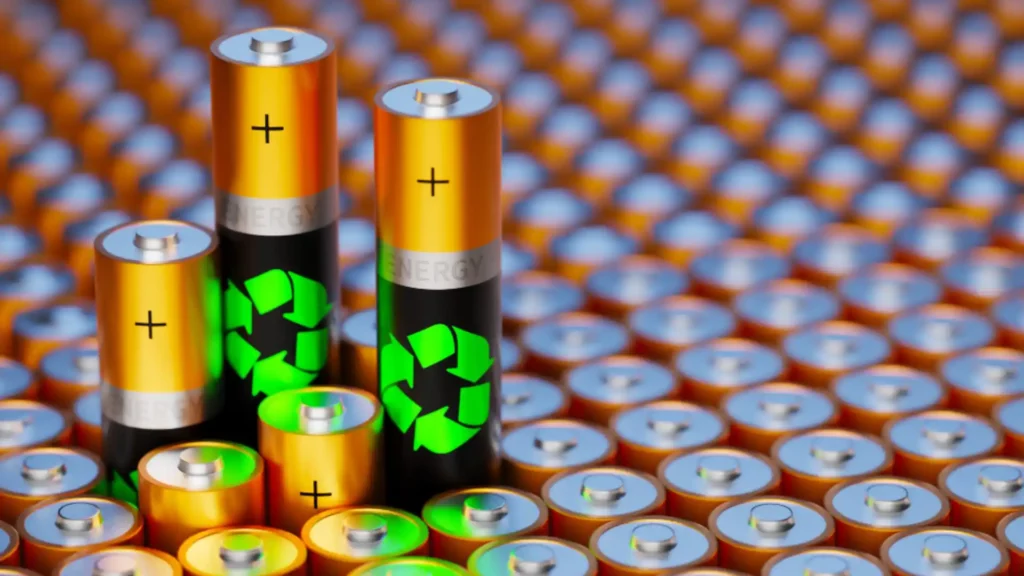
Battery Storage Round Trip Efficiency: Key Aspects and Evaluation
The concept of battery storage round trip efficiency is crucial in the context of energy storage systems. This section focuses on defining and understanding the nuances of battery storage round trip efficiency and its impact on energy storage solutions.
Defining Battery Storage Round Trip Efficiency
Battery storage round trip efficiency is a measure that indicates how efficiently a battery can store and then release the energy it has been charged with. This efficiency is calculated by comparing the amount of energy input into the battery during charging to the amount of usable energy output during discharge. A higher battery storage round trip efficiency signifies that a larger portion of the input energy is available for use, making the battery more effective and economical for energy storage purposes.
Importance of Battery Storage Round Trip Efficiency in Energy Systems
In the field of energy storage, especially in systems like grid storage or electric vehicles, battery storage round trip efficiency plays a pivotal role. It directly affects the viability and performance of the storage system. High-efficiency levels mean more energy is available for use from each charging cycle, which is crucial for the overall energy efficiency and operational cost of the system. As such, battery storage round trip efficiency is a key parameter in the selection and design of battery systems for various applications.
Round Trip Efficiency Battery Storage: A Brief Overview
The term roundtrip efficiency in battery storage is a vital metric in the energy sector. This section provides a succinct overview of what round trip efficiency battery storage entails and its significance.
Understanding RoundTrip Efficiency Battery Storage
Round trip efficiency in battery storage refers to the measure of how effectively a battery can store and then return the energy that is put into it. It is a crucial indicator of a battery's performance, affecting the viability and efficiency of energy storage systems. This efficiency is especially important in applications where energy conservation and effective storage are key, such as in renewable energy systems and electric vehicles.
The Role of Round Trip Efficiency in Battery Storage Systems
The significance of roundtrip efficiency battery storage cannot be overstated. It directly influences how much stored energy is actually usable, impacting the overall effectiveness and cost-efficiency of the storage system. High round trip efficiency battery storage means more energy is available for use, reducing waste and improving the sustainability of the system.
Round Trip Efficiency of Battery Formula: Essential Calculation
The round trip efficiency of battery formula is a fundamental equation in battery technology. This section is dedicated to explaining the round trip efficiency of battery formula and its application in measuring battery performance.
The Basic RoundTrip Efficiency of Battery Formula
At its core, the roundtrip efficiency of battery formula involves a simple calculation: dividing the energy output of the battery (measured in watt-hours or kilowatt-hours) by the energy input required to charge the battery, and then multiplying by 100 to express it as a percentage. This formula is critical for determining how much energy a battery can effectively use out of the total energy it consumes during the charging process.
Practical Applications of the Formula
In practical terms, the round trip efficiency of battery formula is used extensively by engineers and technicians to assess the performance of different types of batteries. This formula helps in comparing the efficiency of various battery technologies and designs, playing a crucial role in battery research and development. A higher percentage obtained from this formula indicates a more efficient battery, with less energy lost during charging and discharging cycles.
The round trip efficiency of battery formula is not just a theoretical tool; it has significant practical implications in the development and selection of batteries for various applications, from small electronics to large-scale energy storage systems.
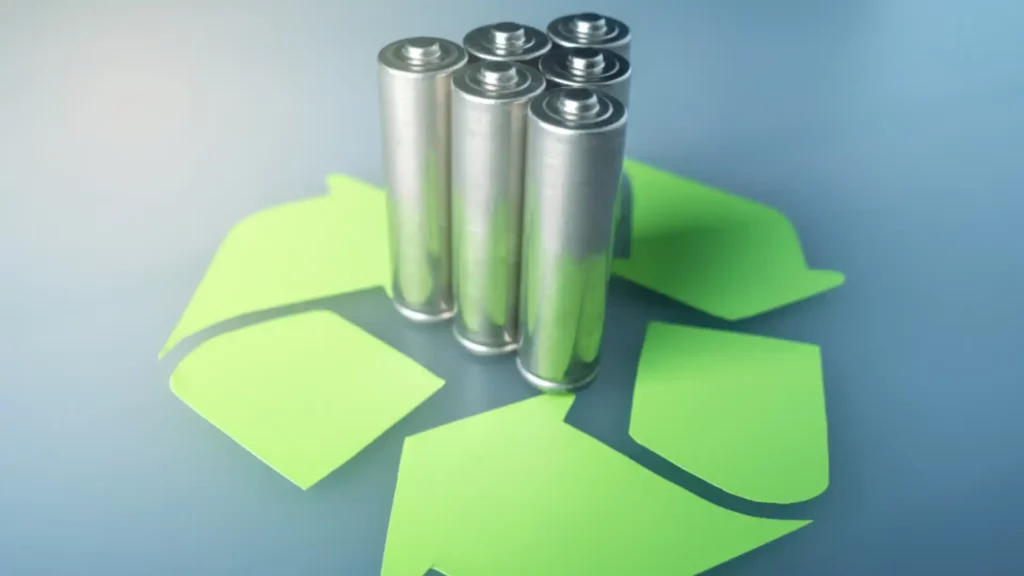
Tesla Battery Round Trip Efficiency: Insights into Performance
Tesla battery round trip efficiency is a key metric that highlights the effectiveness of Tesla's battery technology. This section aims to shed light on the specifics of Tesla battery round trip efficiency and its implications.
Understanding Tesla Battery Round Trip Efficiency
Tesla battery round trip efficiency refers to the efficiency with which Tesla's batteries can store and then release energy. This efficiency is a critical aspect of Tesla's battery technology, reflecting how much energy is retained and available for use after charging. The higher the round trip efficiency, the more effective the battery is at minimizing energy losses during charge and discharge cycles.
Significance of Tesla Battery Round Trip Efficiency in Electric Vehicles
Tesla battery round trip efficiency is particularly important in the context of their electric vehicles (EVs). High round trip efficiency means that more of the energy stored in the vehicle's battery is available for driving, enhancing the vehicle's range and overall performance. Tesla's focus on optimizing battery round trip efficiency has been a significant factor in their EVs' success, as it directly impacts driving range, charging times, and the overall user experience.
Frequently Asked Questions (FAQs) About Battery Efficiency
What is Round Trip Efficiency of Battery?
Round trip efficiency of a battery refers to the measure of how effectively a battery can store and then release the energy that is put into it during charging. It is calculated by dividing the energy output during discharge by the energy input during charging, then multiplying by 100 to get a percentage. A higher value indicates that the battery is more efficient, losing less energy in the process of charging and discharging.
How Does Temperature Affect Battery Efficiency?
Temperature can significantly impact the efficiency of a battery. Extreme temperatures, both hot and cold, can affect the chemical reactions within a battery, thereby impacting its ability to store and release energy efficiently. Typically, high temperatures can accelerate degradation, while low temperatures can reduce the battery's effective capacity.
Can the Round Trip Efficiency of a Battery Improve Over Time?
Generally, the round trip efficiency of a battery decreases over time as the battery undergoes wear and tear from repeated charging and discharging cycles. However, advancements in battery technology, materials, and management systems can lead to improvements in newer batteries. Ongoing research is focused on developing batteries with longer lifespans and better efficiency retention over time.
What Factors Influence the Round Trip Efficiency of Electric Vehicle Batteries?
Several factors influence the round trip efficiency of electric vehicle (EV) batteries. These include the battery's chemical composition, design, the efficiency of the battery management system, and operational conditions such as temperature and charging habits. Additionally, the way the vehicle is driven and the efficiency of other vehicle systems can also impact the overall round trip efficiency of the battery.
Conclusion: The Future of Round Trip Efficiency in Battery
This concluding section will summarize the critical importance of round trip efficiency in batteries, reflecting on the discussed topics. It will envision the future of battery technology with a focus on efficiency, considering the potential impacts on various industries, the environment, and society at large.
Round Trip Efficiency
Energy Storage System Efficiency

Related Posts
Is ceramic heater energy efficient, xiaomi electric vehicle: embrace superior safety and extraordinary efficiency, carbon capture and storage india: essential strategies for environmental excellence, best energy-efficient light bulbs 2024.
Type above and press Enter to search. Press Esc to cancel.
Sign In or Register
Welcome back.
Login to your account below.
HOMER Pro 3.15
- Zoom Window Out
- Larger Text | Smaller Text
- Hide Page Header
- Show Expanding Text
- Printable Version
- Save Permalink URL
The battery round-trip efficiency is the round trip DC-to-storage-to-DC energy efficiency of the storage bank, or the fraction of energy put into the storage that can be retrieved. Typically it is about 80%. HOMER assumes the storage charge efficiency and the storage discharge efficiency are both equal to the square root of the round-trip efficiency.
Battery Charge Efficiency
Battery Discharge Efficiency
- POWER Plant ID
- POWER Events
- Connected Plant
- Distributed Energy
- International
- COVID-19 Coverage
- Carbon Capture
- Climate change
- Cybersecurity
- Distributed Power
- Electric Vehicles
- Energy Storage
- Environmental
- Instrumentation & Controls
- Legal & Regulatory
- Legislative
- Ocean/Marine
- Physical security
- Plant Design
- Power Demand
- Research and Development
- Supply Chains
- Tidal Power
- Waste to Energy
- About POWER
- Privacy Policy
- Cookie Settings
- Diversity, Equity, Inclusion & Belonging
- Accessibility Statement
Don’t Neglect Round-Trip Efficiency and Cost of Charging When Considering Levelized Cost of Storage
The world is moving toward renewable sources for electricity generation in an attempt to reduce fossil-fuel reliance. But wind and solar can’t provide a consistent flow of power 24/7, and grid operators have realized that new electricity generation needs to be paired with storage to manage periods with no sun or wind.
The decreasing cost of lithium-ion batteries has made battery energy storage systems (BESS) more affordable; however, the cost of battery storage systems represents only 20%-25% of any project’s lifetime cost. Power equipment, land, site work, cabling, project design and management, grid integration, transportation, and other related up-front costs represent another 25%.
So, what makes up the other ~50%? Operations and maintenance, otherwise known as O&M, represent a few percentage points. O&M generally includes expenses associated with maintaining, repairing, and operating energy storage systems over their lifespan. The rest comes from the cost of electricity to charge the system, which is significantly affected by the system’s overall round-trip efficiency (RTE).
Why RTE and Cost of Energy Matter
Levelized cost of storage (LCOS) is a metric used to determine the cost per unit of energy discharged from an energy storage system. The calculation is usually expressed in dollars per megawatt hour (MWh) and includes initial costs plus operating costs divided by the energy discharged over the asset’s service life.

There are dozens of potential variables that may be used to determine the true levelized cost of storage, and different vendors will add, omit, or adjust different ones to put their products in the best light. This is why it’s so important to understand the role of RTE and cost of energy in a storage system, because they often have the biggest impact. These are also components that vendors with low-RTE technologies will most often discount (or omit altogether).
Round-trip efficiency is a measure of the amount of energy put into a system compared to the amount dispatched, and is expressed as a percentage. A system with a high RTE (75%+) is able to dispatch most of the energy fed into it. A low RTE indicates that the system loses a considerable amount of energy, often to heat arising from irreversible side reactions or high internal cell resistance. Many long-duration energy storage systems have RTEs below 50%, creating a significant amount of energy waste.
For example, lithium-ion batteries generally have RTEs of 90%+. In contrast, lead-acid batteries have lower RTEs of around 70%, meaning that approximately 30% of charge energy is lost. RTEs for flow batteries can range from 50%–75%, while metal-air batteries could have RTEs as low as 40%.
If the electricity used to charge low-RTE batteries was free, efficiency might not matter much. But electricity always comes with a cost. Some might argue that during periods where supply exceeds demand, renewables could be used to charge batteries when they would otherwise be curtailed. There’s a logic to that, but curtailment periods can’t always be predicted.
Even if you’re using electricity that would otherwise be curtailed, you have to assign a monetary value. If a turbine is spinning or a solar panel is generating electricity and a battery system is storing that electricity, every component in the system is subject to normal wear and tear plus maintenance and replacement protocols—all of which have costs associated. Factors at play include:
Technology lifespan and degradation rate. An energy storage system’s service life is determined by technology and cycles. All energy storage systems deteriorate over time, making them less efficient at storing and discharging energy. The same goes for generation sources. From solar to wind to flow batteries to lithium-ion, the more the components are used, the shorter the lifespan and the sooner the need for repair, replacement or augmentation.
Maintenance costs. Solar panels, wind turbines, battery systems, transmission lines, and power equipment all have to be maintained. The more they’re used, the more often components need to be serviced or replaced.
Long-Duration Doesn’t Always Mean Lower LCOS
The latest buzzy term in the energy space is “long-duration energy storage,” or LDES for short. While there’s no single definition of what the term means, the term has generally come to describe a non-lithium storage technology that can provide energy for anywhere from 8 to 160 hours at a lower installed cost per MW than lithium-ion batteries or a standard natural gas turbine.
LDES isn’t confined to battery storage; non-battery technologies include compressed air, latent heat, flywheels, and more. In fact, pumped hydro currently accounts for the vast majority of all LDES capacity in the US, and will likely remain in that position for an extended time. Battery technologies being positioned for LDES use include flow batteries, zinc-based chemistries, metal air, nickel hydrogen, and more.
These technologies all work well and are generally safer than lithium-ion batteries, but they come with trade-offs. Many have high up-front costs and must be amortized over 30–40-year periods to be cost competitive. Some have very low energy densities, requiring significant amounts of land for installations above a few megawatt hours. Some are rate-limited and can’t discharge as quickly as needed for specific applications. Some have very restricted siting requirements. And maybe most importantly, many have RTEs below 60%, with a few at 40% or lower.
So, what does this all mean? The race is on to build a better storage system, and with no universal standard for calculating LCOS, every vendor is using a model that plays to the strength of their own technology. If you’re investigating a new storage technology, be sure to ask a few questions when LCOS numbers come up, such as:
How many years are they calculating when it comes to system life? Lithium-ion batteries usually have to be augmented or replaced somewhere between 10 and 15 years of use; vendors with low densities or high installed costs may calculate over 30–40 years to lower their LCOS while factoring in two or more replacement cycles for lithium-ion.
What are they using for the cost of electricity to charge the system, and how does that compare with your actual costs? Even if you’re only planning to charge the system during periods you’d normally be curtailing renewables, remember that there’s still a cost to running those systems. A system with a low RTE may end up having a much higher LCOS even when you’re paying very little for electricity.
Are they including the cost of land in their calculations? If you’re installing a storage facility in a rural area where land is cheap, this may not matter so much. But if you need to place storage in or near a high-cost-of-living area, cost of land (and availability) could be one of your primary concerns and should definitely play a role in the LCOS calculation.
Are they including installation tax credits (ITCs) or production tax credits (PTCs) in their calculations? If so, be sure that the numbers are correct for your projects, and that the same are being applied to any other technologies you’re evaluating.
— Mukesh Chatter is the CEO of Alsym Energy , a technology company developing a low-cost, high-performance rechargeable battery chemistry that is free of lithium and cobalt.
SHARE this article

how to calculate battery storage round trip
How to Calculate Battery Storage Round Trip

Understanding Battery Storage Round Trip
The formula for calculating round trip efficiency.

Example Calculation
Factors impacting round trip efficiency, importance of round trip efficiency calculation.
In conclusion, calculating battery storage round trip efficiency is essential for evaluating the performance and cost-effectiveness of battery storage systems. By using the appropriate formula and considering the various factors that impact round trip efficiency, you can make informed decisions about the selection and optimization of battery storage systems.
Leave a Comment Cancel Reply
Your email address will not be published. Required fields are marked *
Save my name, email, and website in this browser for the next time I comment.
Notify me via e-mail if anyone answers my comment.
WhatsApp us
- Project Finance

- Battery Storage
- Diesel Generators
- MWM Gas Engines
- MWM TCG 3016
- MWM TCG 3020
- MWM TCG 2020
- MWM TCG 2032
- Battery Energy Storage
- Cogeneration (CHP)
- Electricity Generation
- Energy Resilience
- Hybrid Power Solutions
- Quadgeneration
- Trigeneration (CCHP)
- Project Design, Engineering & Build
- Project Management
- Power Plant Commissioning
- Containerised Power Plant
- Energy Centres
- Existing buildings or boiler house
- Power Island
- Agriculture
- Commercial Buildings
- Data Centres
- District Heating
- Food and Drink Manufacturing
- Glasshouses
- Industrial and Manufacturing
- Peaking Plants
- Pharmaceuticals
- Sewage and Waste Treatment
- Case Studies

Battery Energy Storage System (BESS)
What is a battery energy storage system.
- How does BESS work?
Advantages of battery energy storage systems
- Battery energy storage system components
Principal BESS characteristics
- Types of Battery Chemistry
- Battery Energy Storage Applications
- BESS revenue sources
- Why is energy storage needed?
- What are the alternatives to BESS on energy storage?
A battery energy storage system (BESS) captures energy from renewable and non-renewable sources and stores it in rechargeable batteries (storage devices) for later use. A battery is a Direct Current (DC) device and when needed, the electrochemical energy is discharged from the battery to meet electrical demand to reduce any imbalance between energy demand and energy generation. The increase in renewable energy sources and drive to achieve net zero carbon make BESS an essential technology for commercial and industrial organisations. By adopting BESS, it can provide a vital pathway in the transition to green energy and accelerate your journey towards net zero.
How does a battery storage system work?
A BESS collects energy from renewable energy sources, such as wind and or solar panels or from the electricity network and stores the energy using battery storage technology. The batteries discharge to release energy when necessary, such as during peak demands, power outages, or grid balancing. In addition to the batteries, BESS requires additional components that allow the system to be connected to an electrical network. A bidirectional inverter or power conversion system (PCS) is the main device that converts power between the DC battery terminals and the AC line voltage and allows for power to flow both ways to charge and discharge the battery. The other primary element of a BESS is an energy management system (EMS) to coordinate the control and operation of all components in the system.
BESS Power and Energy Ratings
For a battery energy storage system to be intelligently designed, both power in megawatt (MW) or kilowatt (kW) and energy in megawatt-hour (MWh) or kilowatt-hour (kWh) ratings need to be specified. The power-to-energy ratio is normally higher in situations where a large amount of energy is required to be discharged within a short time period such as within frequency regulation applications. For pricing purposes, however, the quoted measure is usually the energy rating.
What is the Battery C‐Rate?
A battery’s C rating is the rate at which a battery can be fully charged or discharged. For example, charging at a C-rate of 1C means that the battery is charged from 0 - 100% or discharged from 100 - 0% in one hour. A C-rate higher than 1C means a faster charge or discharge, for example, a 2C rate is twice as fast (30 minutes to full charge or discharge). Likewise, a lower C-rate means a slower charge or discharge, as an example, a C-rate of 0.25 would mean a 4-hour charge or discharge. The formula is: T = Time Cr = C-Rate T = 1 / Cr (to view in hours), or T = 60 min / Cr (to view in minutes). For example:
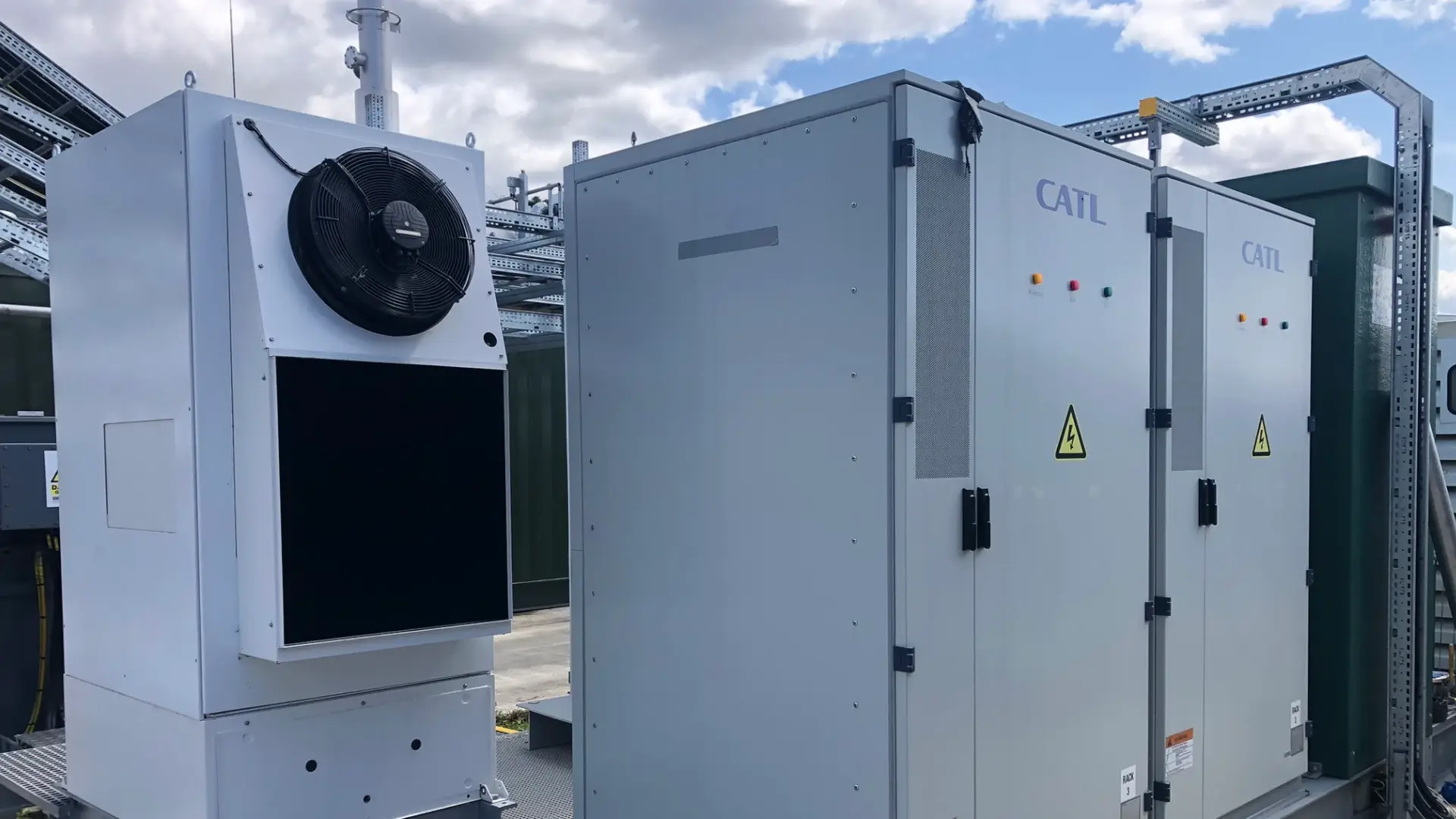
Battery storage systems have several advantages when paired with renewable energy and non-renewable forms of generation. Solar and wind can be unpredictable, so battery storage systems are a key component in steadying energy flow by providing a steady supply whenever required, irrespective of weather conditions. Additionally, BESS can protect users from potential supply interruptions that could threaten the energy supply. Here are some of the benefits of battery storage systems:
Environmental
Installing a battery energy storage system powered by renewable energy generation technologies helps reduce carbon emissions from fossil fuels and contributes to the net zero pathways in combatting the effects of global warming.
Reduce energy costs
BESS allows consumers to store low-cost solar energy and discharge it when the cost of electricity is expensive. In doing so, it allows businesses to avoid higher tariff charges, reduce operational costs and save on their electricity bills.
Reduce grid dependency
Battery storage systems guarantee a continuous energy supply, even at times when the network is unstable due to peaks in demand or extreme weather events.
“Always on” supply
The sun is not always “on.” A battery storage system works round the clock and therefore compensates for any fluctuations in solar energy supply by storing any excess energy and maximise renewable energy generation.
Enhanced Resilience
A full battery energy storage system can provide backup power in the event of an outage, guaranteeing business continuity.
Co-location of Assets
Battery systems can co-locate solar photovoltaic, wind turbines, and gas generation technologies. In doing so, BESS co-location can maximise land use and improve efficiency, share infrastructure expenditure, balance generation intermittency, lower costs, and maximise the national grid and capacity.
Frequency Control
The battery energy storage system can regulate the frequency in the network by ensuring it is within an appropriate range. Discrepancies between generated and required energy can cause short-term problems, such as outages or blackouts, but BESS can quickly react and secure sub-second frequency response, stabilising the network. Additionally, it guarantees voltage stability by keeping it within established boundaries.
In summary:
- Battery storage can improve the reliability, availability, and efficiency of the power supply
- BESS solutions can accelerate decentralised power station infrastructure which can add value to commercial and utility-scale power generation models
- Battery storage has no significant restriction on the geographical locations that it can be sited in. Storage technologies such as pumped hydro and compressed air are only suitable for a limited number of places
- High energy density (resulting in reduced footprint) and fast response time (<150ms achievable)
Battery Energy Storage System Components
BESS solutions include these core components: Battery System or Battery modules – containing individual low voltage battery cells arranged in racks within either a module or container enclosure. The battery cell converts chemical energy into electrical energy. The batteries are connected in series and parallel for the required capacity. Storage enclosure - either as an outdoor module or containerised solution along with thermal management. Battery Management System (BMS) – which ensures the battery cell's safe working operation, ensuring it operates within the correct charging and discharging parameters. In doing so, the BMS monitors the battery cell's current, voltage, and temperature and estimates its state of charge (SoC) and State-of-Health (SoH) to prevent safety risks and ensure reliable operation and performance. Inverter or a Power Conversion System (PCS) – the battery cell produces direct current (DC), which the PCS converts into alternating current (AC) used for the power grid, commercial or industrial applications. Bidirectional inverters allow for the charging and discharging of the battery cell. Energy Management System (EMS) – controls and monitors the energy flow of the BESS and systems. The EMS coordinates the BMS, inverters and other components of the battery energy system by collecting and analysing data used to manage and optimise the overall system performance. Safety Systems – subject to system functionality and operating conditions, a BESS will include fire suppression, smoke detection, a temperature control system, and cooling, heating, and air conditioning systems. A dedicated monitoring and control system will ensure the safe operation of the BESS and the prevention of fire and hazardous incidents. The BESS will also be housed within a secure restricted access area and include CCTV monitoring.
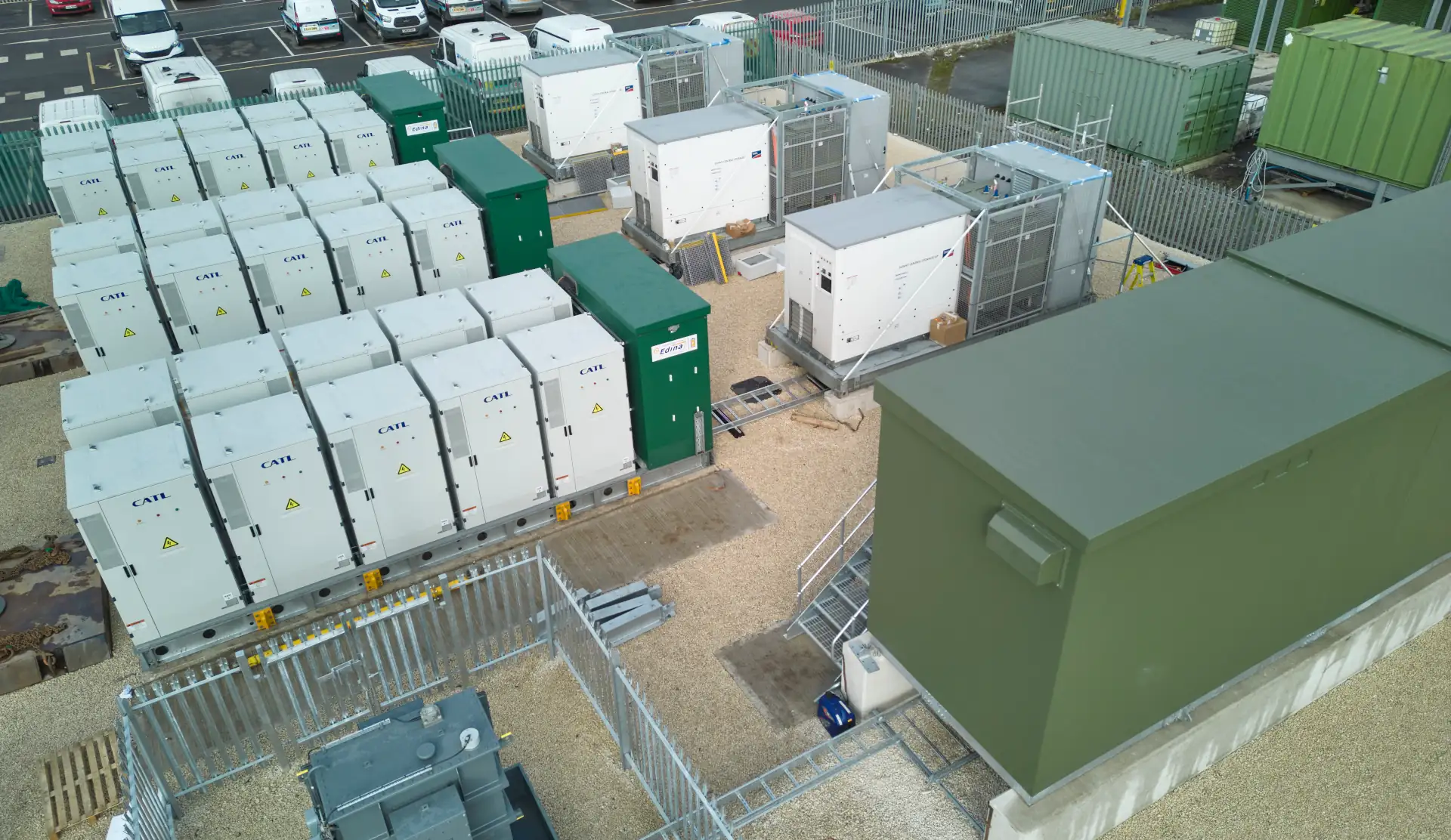

Rated Power Capacity
Rated Power Capacity is the total discharge capability (usually in megawatts (MW)) or the maximum rate of discharge the BESS can achieve, starting from a fully charged state.
Rated Energy Storage
Rated Energy Storage Capacity is the total amount of stored energy in kilowatt-hours (KWh) or megawatt-hours (MWh). Capacity expressed in ampere-hours (100Ah@12V for example).
Storage Duration
The amount of time storage can discharge at its power capacity before exhausting its battery energy storage capacity. For example, a battery with 1MW of power capacity and 6MWh of usable energy capacity will have a storage duration of six hours.
Depth of Discharge (DoD)
Depth of Discharge (DoD) expresses the total amount of capacity that has been used.
Cycle life / lifetime
The amount of time or cycles a battery storage system can provide regular charging and discharge before failure or significant degradation. Cycle Life is the number of times a battery storage part can be charged and discharged before failure, often affected by Depth of Discharge (DoD), for example, one thousand cycles at a DoD of 80%.
Self-discharge
Self-discharge occurs when the battery's stored charge (or energy) is reduced through internal chemical reactions or without being discharged from performing work for a customer or the grid. Self-discharge is usually expressed as a percentage of the charge lost over a certain period. It is an essential parameter in batteries intended for longer-duration applications.
Discharge Rate
Discharge Rate (C) describes the current that a battery can deliver for a period of time, as an example, C5 is the current a battery will provide over 5 hours to reach full discharge.
State of Charge
The state of charge is usually expressed as a percentage representing the battery's present charge level and ranges from wholly discharged to fully charged. The state of charge influences a battery's ability to provide energy or ancillary services to the network at any given time. The state of Charge expresses the amount of capacity remaining.
Round-trip Efficiency
Round-trip efficiency is the ratio of energy charged to the battery to the energy discharged from the battery and is measured as a percentage. It can represent the battery system's total AC-AC or DC-DC efficiency, including losses from self-discharge and other electrical losses.
In addition to the above battery characteristics, BESS have other features that describe its performance.
The ramp rate is the rate at which the BESS may decrease or increase its power output - ramp down or up, respectively.
Response Time
The response time is when BESS must move from the idle state and start working at full power.
Types of Battery Chemistries
Lithium-ion (li-ion).
Lithium iron phosphate (LFP) and lithium nickel manganese cobalt oxide (NMC) are the two most common and popular Li-ion battery chemistries for battery energy applications. Li-ion batteries are small, lightweight and have a high capacity and energy density, requiring minimal maintenance and provide a long lifespan. Lithium-ion batteries can also be rapidly charged and have a low self-discharge rate. The disadvantages of this battery technology include excessive cost, inflammability, intolerance to extreme temperatures, overcharge, and over-discharge.
Lead-Acid (PbA)
Lead-Acid batteries are well-proven within the automotive industry and behind-the-meter grid and UPS applications. PbA batteries are widely available, low cost, widely recyclable, and can perform effectively at both hot and cold temperatures. However, due to advances in Li-ion battery technology, lead-acid batteries have a low energy density and are slow to charge.
Sodium-Sulphur (Na-S)
A sodium-sulphur battery is a molten salt-based device. Na-S batteries have several advantages, including high energy and power density, a long lifespan, and reliable operation under extreme 300 to 350 degrees Celsius temperatures. However, this battery technology is primarily suited to large-scale stationary grid storage applications due to high operating temperatures and corrosion sensitivity. Sodium is also a dangerous component because it is highly flammable and potentially explosive.
Flow Batteries
Flow batteries store energy in liquid electrolyte solutions, unlike traditional rechargeable battery solid electrode material. The vanadium redox battery (VRB) is the most prevalent flow battery type and is suitable for longer durations of up to 8 hours or where an extended lifetime is required. Despite their low energy capacity and charge/discharge rate, flow batteries respond quickly and reduce fire risk due to the non-flammable electrolytes used.
Zinc Bromine, cerium-zinc
A zinc-bromine battery is a rechargeable battery that uses the reaction between bromine and zinc metal to produce an electric current with an electrolyte composed of an aqueous solution of zinc bromide. The zinc-bromine battery was developed as an alternative to lithium-ion batteries for stationary power applications from grid-scale to domestic scale. The water-based electrolyte in Zinc-bromine batteries makes the battery system less prone to fire and overheating than lithium-ion batteries.

BESS Applications
Battery energy storage can be beneficial for several reasons due to the flexibility of co-locating with other renewable energy sources or non-renewable sources. Battery energy storage also requires a relatively small footprint and is not constrained by geographical location. Let’s consider the below applications and the challenges battery energy storage can solve.
Peak Shaving / Load Management (Energy Demand Management)
A battery energy storage system can balance loads between on-peak and off-peak periods. The electricity demand fluctuates depending on the day of the week, time of day, and seasonality. As such, when there is peak electrical demand, prices are at their most expensive. Alternatively, the power price is at the standard rate when demand is low during off-peak periods. Peak shaving allows users with battery energy storage systems the assets to store power during off-peak periods and discharge during peak times to reduce electricity costs.
Energy Time Shifting / Arbitrage
Energy time shifting or arbitrage allows users with BESS solutions to store their purchased power during off-peak times to use on-site when the imported power price is high. Alternatively, users can trade their stored electricity via the flexibility markets (Energy Markets, Ancillary Services, and Capacity Market) for income generation.
Battery energy storage can supply fast response backup power in the event of a mains failure to ensure infrastructure is operational and downtime is minimal. Using these battery energy storage systems alongside power generation technologies such as gas-fired Combined Heat and Power (CHP) , standby diesel generation , and UPS systems will provide increased resilience mitigating a potential loss of operational costs, whilst protecting your brand.
Frequency Response
A BESS has a frequency response which allows it to provide active power output when there is a change in the electrical grid's frequency. A deviation from the nominal frequency indicates a mismatch between power supply and demand, which can destabilise the grid, causing outages or blackouts. To restore balance quickly, the BESS can adjust its active power output by reacting to deliver sub-second frequency response to stablise and balance supply and demand within the network. The growing share of renewable generation and decentralised power plants connected to the network, means battery storage will continue to play a critical role in our energy transition.
Grid Connected
In Front-of-the-Meter (FtM) applications battery storage systems are typically referred to as utility or grid-scale battery storage and can be connected to transmission or distribution networks to reduce congestion management whilst also controlling voltage and providing reserve and ancillary services. A BESS can also support power generation assets.
Commercial and Industrial
BESS are typically Behind-the-Meter (BtM), and applications include avoiding electricity network charges, benefiting from tariff differences, delivering value-added balancing services, or enhancing on-site resilience and energy consumption when paired with on-site solar PV, thus saving money and optimising the sustainability benefits.
Co-location
BESS can be paired with other renewable and non-renewable technologies to form a hybrid power solution . For example, these hybrid systems can enhance the performance of new and existing gas engine installations. Combining a battery storage system with gas generation and solar power will go a long way to making cheaper, cleaner and more reliable power more accessible.
What are the sources of BESS revenues?
BESS projects can be attractive by obtaining ‘stacked’ revenue streams. These include:
Capacity Markets
Participants may earn revenue for entering into commitments under a statutory contract called a ‘Capacity Agreement’ with the Government. These Capacity Agreements provide a backup electricity supply to meet peak demand during system stress. The agreements may have a duration of up to 15 years.
Offtake Agreements
These agreements are with the consumers for a negotiated price. The contracts are known as Power Purchase Agreements or PPA. PPAs may have a duration of up to 15 years.
Dynamic Frequency Response
Dynamic Frequency Response provides an extremely valuable source of income. However, contracts with the National Grid typically have two years. Under the dynamic frequency response contracts, the operator responds to fluctuations in demand on the network by reducing or increasing its energy consumption. This is organised through the Dynamic Containment Service.
Energy Arbitrage
Users with BESS assets can optimise their energy usage to lower costs, improve sustainability or reduce costs. Electricity can be purchased and stored when prices are cheap and discharged during peak times to offset energy costs.
DS3 Programme
The main driver for battery storage in Ireland is the DS3 (Delivering a Secure Sustainable Electricity System) programme, which was brought in to enable Ireland to meet its 2020 renewable energy targets and to manage the increased amount of renewable generation connected to the grid.
The DS3 programme allows the system operator to procure ancillary services, including frequency response and reserve services; the sub-second response needed means that batteries are well placed to provide these services.
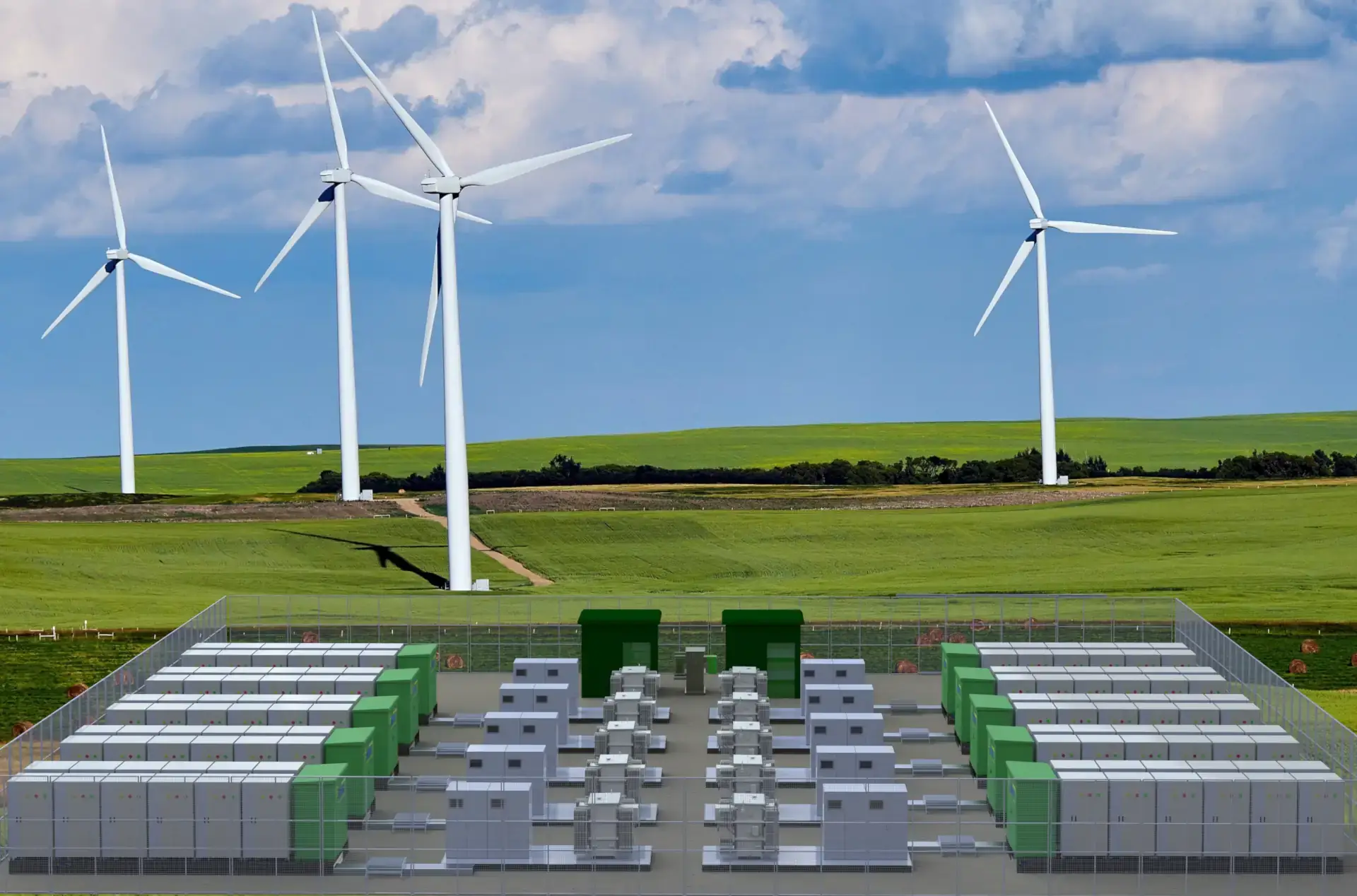
Why is Energy Storage needed?
Most energy systems have a varying demand with some short-term but significant peak power requirements, which results in a capacity requirement which might only be used for a fraction of the time. Energy storage enables energy to be saved for later use.
Energy storage creates capabilities and efficiencies low cost energy for the electric grid and assists in mitigating climate change.
Renewable energies are intermittent in nature, i.e., their capacities to produce energy vary with time. Energy storage from renewable energies can avoid any curtailment of renewable energies during favourable weather conditions when excess wind or solar energy gets generated.
The UK government estimates that technologies like batteries will form part of the UK’s smarter electricity grid, heat and transport technologies, supporting the integration of more low-carbon power, could save the UK energy system up to £40 billion by 2050 .
What are alternatives to BESS on energy storage?
Aside from battery energy storage systems, other energy storage technologies include:
Pumped Hydro
During periods of low electricity demand, surplus generation is used to pump water from a low-elevation reservoir up to a high-level elevation. When water is released from the high-level elevation, it flows down through a turbine to generate electricity to meet peak demand.
Compressed Air
Electricity is used to compress ambient air, which is stored under pressure in underground caverns or containers. When electricity demand is high, the pressurised air is heated and released into an expansion turbine generator for power production.
It is a way by which mechanical energy may be stored in the form of potential or kinetic energy. Electric motors accelerate a flywheel at high speeds through which the energy is stored as kinetic rotational energy. When there is an electricity demand, the spinning force of the flywheel is connected to a generator to produce power.
Thermal Energy
Electricity may produce thermal energy, which can be stored until needed. For example, electricity can be used to make chilled water during low demand and later used for cooling during peak electricity consumption. The UK's gas system distributes about twice as much energy as electricity, and this energy is used for heating. Heating demands vary with season and time of day, and thermal energy storage can load shift and smooth demand on the plant. Move heat from the summer to the winter.
Contact us about our BESS solutions

Talk To One Of Our Battery Energy Storage Specialists
Are you looking to deploy Battery Energy Storage Systems? We are a BESS turnkey EPC contractor and systems integrator of advanced global Tier 1 battery and inverter technologies to provide an industry-leading battery energy storage solution that is scalable and delivers guaranteed performance.
- Applications
- Industrial Manufacturing

- Terms of Use
- Privacy Policy and Cookies
- Modern Slavery Policy


Thunder Said Energy
the research consultancy for energy technologies
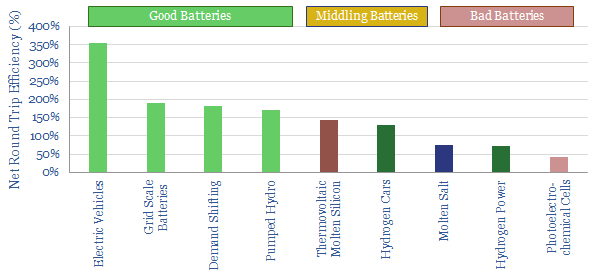
Round Trip Battery Efficiencies
This data-file derives the ‘net round trip efficiency’ of nine different battery solutions for storing energy. Rough costs are also estimated.
Net round trip efficiency is calculated as the energy efficiency of the battery (kWh recovered per kWh fed in) divided by the energy efficiency of the displaced energy source.
We see great potential in “good batteries” , for example, electrification of the vehicle fleet, which can achieve c3.5x uplifts in efficiency. We see less potential in “bad batteries”, for example, backing up the grid with hydrogen, which reduces total system efficiency by c35%.
Privacy Overview
- ExxonMobil to supply U.S. produced Lithium to SK On
- Castrol to invest USD 50M in Gogoro’s battery swapping ecosystem
- ElectroRide and Battery Smart to establish battery swapping at 2,500 locations across India
- Amara Raja to license LFP cell technology from Gotion-InoBat-Batteries
- Musashi starts production of EV e-2W e-axles in India
Understanding Battery Energy Storage System (BESS) | Part 2 – Advanced
The first part of this series covers the basics and constituents of BESS in the Dec 2022 issue of EVreporter magazine. In continuation, part 2 explores BESS in-depth and discusses BESS design and technical parameters in greater detail.
BESS Design
The market is shifting towards the 1500V DC system of BESS. Below is a possible design that can be used in such a high-voltage system.
- 44 cells of 280Ah, 3.2V connected in series in one module
280Ah, 44*3.2V = 280Ah, 140.8V i.e. 39.424 kWh/module
44S1P cell configuration in the module
- 9 individual modules connected in series in one rack
280Ah, 9*140.8V = 280Ah, 1267.2V i.e. 354.816 kWh/rack
396S1P cell configuration in the rack
- 9 racks connected in parallel in one 20 feet container
9*280Ah, 1267.2V = 2520Ah, 1267.2V i.e. 3.19MWh
396P9P cell configuration for the entire 20 feet container
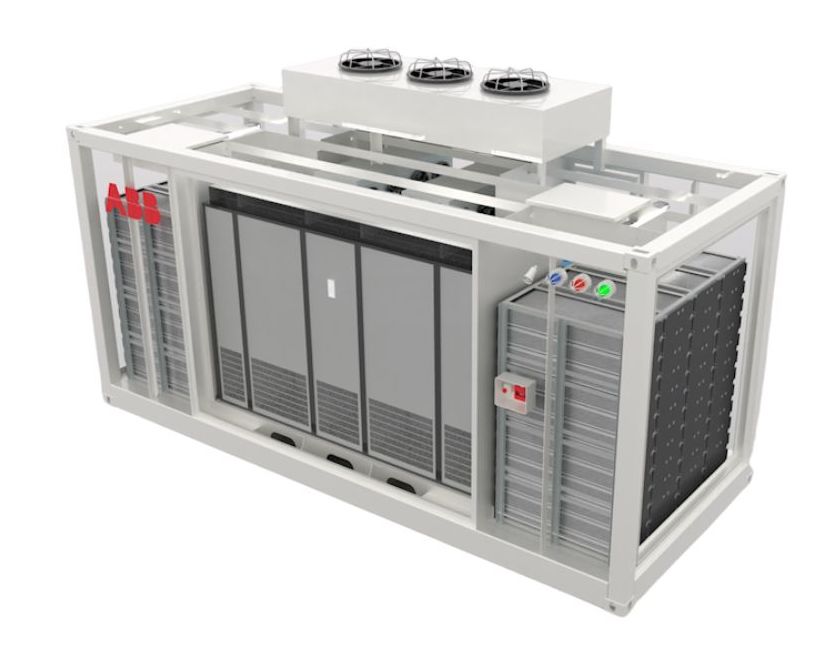
Inputs for designing BESS
- 280Ah, 3.2V LFP Prismatic cell is very popularly used in BESS, and the same is considered for the above design.
- 44 number of cells connected in series in a module can also be increased to 48 and 52 series. The number of modules per rack can be 8 or 9, depending on the height of the module and the container selected.
- The number of racks in a 20 feet container can be 9 or 10.
The below image shows a line diagram of a popular type of BESS + Solar system:

Battery Thermal Management System (BTMS) – BESS operating without thermal management in high temperatures can lead to lower battery cycle life. On the other hand, batteries operating without thermal management in lower temperatures (sub-zero temperatures) can lead to lower output of energy from the BESS. Hence, keeping the BESS operation close to the ideal operating temperature of the battery, which is 25±2°C in the case of Lithium-ion batteries, is imperative. The temperatures sometimes vary from place to place depending on other environmental conditions such as atmospheric pressure, altitude, etc.
Duck Curve – The name duck curve is derived from the shape of the graph representing the time of the day on the x-axis and energy demand on the y-axis. In some places, due to the duck curve, solar panels are partially turned off to avoid damage to the grid . This situation typically arrives in places that are heavily dependent on Solar PV.

During the peak hours, typically sometime during the noon, the generation tends to be the highest, and if the demand is lower during the same period, a duck curve is expected.
Selection of battery type
BESS can be made up of any battery, such as Lithium-ion, lead acid, nickel-cadmium, etc. Battery selection depends on the following technical parameters:
- BESS Capacity : It is the amount of energy that the BESS can store. Using Lithium-ion battery technology, more than 3.7MWh energy can be stored in a 20 feet container. The storage capacity of the overall BESS can vary depending on the number of cells in a module connected in series, the number of modules in a rack connected in parallel and the number of racks connected in series.
- Power Rating (C rate of Charge and Discharge) : It is the capability of the BESS to charge at a certain speed and discharge at a certain speed. It is directly proportional to the power input and power output, respectively.
- Cycle life : It is defined as the total number of charge and discharge cycles that the BESS can supply during its lifetime by the time it reaches its end-of-life (EOL). Depending on the life expected from the BESS, batteries such as Lead acid batteries (low cycle life) and Lithium Iron Phosphate (LFP) batteries (high cycle life) are used.
- Depth of Discharge (DoD) : It is the percentage of energy discharged from the BESS out of the total energy storing capacity. Lower DoD can ensure higher cycle life of the BESS. Generally, the maximum DoD is set at 90% for BESS.
- Round-trip Efficiency : It is the percentage of energy delivered by the BESS during discharging when compared to the energy supplied to the BESS during charging. Flow battery technology has lower round-trip efficiency compared to Lithium-ion batteries. It means that higher energy is wasted (during charge-discharge) when flow batteries are preferred over Lithium-ion batteries.
- Usable Energy : For the above-mentioned BESS design of 3.19 MWh, energy output can be considered as 2.64 MWh at the point of common coupling (PCC). This is calculated at 90% DoD, 93% BESS efficiency, ideal auxiliary consumption, and realistically considering the conversion losses from BESS to PCS and PCS to Transformer.
- Operating Conditions : The operating temperature is key to selecting the type of battery. For example, an LFP battery would be considered in areas that experience high temperatures. In this scenario, using Lithium Nickel Manganese Cobalt Oxide (NMC) batteries would not be recommended.
About the Author

About the author – Rahul Bollini is a Lithium-ion cell and battery pack R&D expert . He has industrial experience of over 7 years. Rahul can be reached at +91-7204957389 and [email protected].
This article was originally published in EVreporter Magazine Jan 2023 issue that can be accessed here .
Read: Part 3 of this series
Subscribe today for free and stay on top of latest developments in EV domain.

You May Also Like

IIT Guwahati team recommends drivetrain and battery sizing for e-2W in India

A guide to PCB materials used in EV manufacturing

Understanding the Sense-of-Touch technology for safer driving
One thought on “ understanding battery energy storage system (bess) | part 2 – advanced ”.
Pingback: Understanding Battery Energy Storage System (BESS) | Part 1 - BASICS • EVreporter
Leave a Reply Cancel reply
You must be logged in to post a comment.
Thanks, I’m not interested. Please don't ask ask again.
- Product Information
- Where to Buy
- Become a Dealer
- Contact Technical Support

HOW TO CALCULATE THE ENERGY COST OF DIFFERENT BATTERY CHEMISTRIES?
- May 5, 2021
- Fortress Power

Over 90% of newly installed energy storage worldwide are paired with Lithium batteries, even though the cost of the lithium batteries is much higher than the that of Lead Acid batteries. Why do developers, investors and utilities prefer Lithium over Lead Acid? The answer is simple, it delivers much more cycles and costs substantially less over its life span.
Our engineers have studies and tested Lithium Iron Phosphate (LFP or LiFePO4), Lithium Ion (Lithium Nickel Manganese Cobalt) and Lithium Polymer (LiPo), Flood Lead Acid, AGM and Nickel Iron batteries. We compared their round-trip efficiency, life cycles, total energy throughput and cost per kWh.
What’s Battery Energy throughout? It is the total amount of energy a battery can be expected to store and deliver over its lifetime. How to calculate this energy amount? The Energy Throughput is equal to Nominal Capacity x Round-trip Efficiency x Depth of Discharge x Battery Cycle Life . For example, A Fortress LFP-10 has a normal capacity of 10.2 kWh and an exceptional roundtrip efficiency of 98%. We guarantee 6000 cycles at 80% of Depth of Discharge (DoD). The total energy throughput you can obtain from the LFP-10 will be 47 MWH. As a contrast, a 10 kWh AGM battery can only deliver 3.5 MWH total energy, less than 1/10 of the LFP battery.
The Fortress LFP-10 is priced at $ 6,900 to a homeowner. As a result, the energy cost of the LFP-10 is around $ 0.14/kWh ($ 6900/47MWH = $ 0.14/kWh). While a 10 kWh AGM’s energy cost is $ 0.57/kWh, 3.5 times more!
Using the same method, the energy cost of Lithium Ion batteries (such as Tesla, LG Chem, Panasonic) is around $ 0.30/kWh.

If you have any questions or need any further information, please email us at [email protected] or Call us at (877) 497 6937.
Get updates delivered
Recent posts.

GreenLancer Energy & Fortress Power Partnership to Provide Solar Energy Solutions
Detroit, MI, [4/29/2024]—GreenLancer Energy, a nationwide leader in solar design and engineering services, and Fortress Power, a solar battery and inverter manufacturer, are thrilled to

Skylight Lending and Fortress Power Partner to Offer Energy Storage with Financing
Philadelphia, PA [4/24/2024]—Skylight Lending, a nationwide leader in solar system financing, and Fortress Power, an energy storage solutions provider, are thrilled to announce a collaboration

Avalon Roadshow – May 2024: Do More with Less
With the Avalon whole-home energy storage system you can do more with less. Join us for an in-person training near you to learn about the

Por Los Nuestros and Fortress Power Honored with PR Energy Island-Wide Project Award for Solar Aqueducts Project
Por Los Nuestros and Fortress Power Honored with PR Energy Island-Wide Project Award for Solar Aqueducts Project Puerto Rico – March 28, 2024 – Por
See All Blog Posts

JOIN OUR COMMUNITY

Rebates Available for
Members of the Armed Forces and Veterans!
APPLICATIONS
Quick links.
- 2010 Cabot Blvd West Suite L, Langhorne, PA 19047
- [email protected]
877-497-6937
© 2024 Fortress Power. All Rights Reserved.
- Terms of Service
- How do you describe yourself? * Homeowner Installer Distributor Other
- Enter your email address *
- Name * First Last
- Company/Organization *
- Country * United States Canada Mexico Afghanistan Albania Algeria American Samoa Andorra Angola Anguilla Antarctica Antigua and Barbuda Argentina Armenia Aruba Australia Austria Azerbaijan Bahamas Bahrain Bangladesh Barbados Belarus Belgium Belize Benin Bermuda Bhutan Bolivia Bonaire, Sint Eustatius and Saba Bosnia and Herzegovina Botswana Bouvet Island Brazil British Indian Ocean Territory Brunei Darussalam Bulgaria Burkina Faso Burundi Cambodia Cameroon Cape Verde Cayman Islands Central African Republic Chad Chile China Christmas Island Cocos Islands Colombia Comoros Congo, Democratic Republic of the Congo, Republic of the Cook Islands Costa Rica Croatia Cuba Curaçao Cyprus Czech Republic Côte d'Ivoire Denmark Djibouti Dominica Dominican Republic Ecuador Egypt El Salvador Equatorial Guinea Eritrea Estonia Eswatini (Swaziland) Ethiopia Falkland Islands Faroe Islands Fiji Finland France French Guiana French Polynesia French Southern Territories Gabon Gambia Georgia Germany Ghana Gibraltar Greece Greenland Grenada Guadeloupe Guam Guatemala Guernsey Guinea Guinea-Bissau Guyana Haiti Heard and McDonald Islands Holy See Honduras Hong Kong Hungary Iceland India Indonesia Iran Iraq Ireland Isle of Man Israel Italy Jamaica Japan Jersey Jordan Kazakhstan Kenya Kiribati Kuwait Kyrgyzstan Lao People's Democratic Republic Latvia Lebanon Lesotho Liberia Libya Liechtenstein Lithuania Luxembourg Macau Macedonia Madagascar Malawi Malaysia Maldives Mali Malta Marshall Islands Martinique Mauritania Mauritius Mayotte Micronesia Moldova Monaco Mongolia Montenegro Montserrat Morocco Mozambique Myanmar Namibia Nauru Nepal Netherlands New Caledonia New Zealand Nicaragua Niger Nigeria Niue Norfolk Island North Korea Northern Mariana Islands Norway Oman Pakistan Palau Palestine, State of Panama Papua New Guinea Paraguay Peru Philippines Pitcairn Poland Portugal Puerto Rico Qatar Romania Russia Rwanda Réunion Saint Barthélemy Saint Helena Saint Kitts and Nevis Saint Lucia Saint Martin Saint Pierre and Miquelon Saint Vincent and the Grenadines Samoa San Marino Sao Tome and Principe Saudi Arabia Senegal Serbia Seychelles Sierra Leone Singapore Sint Maarten Slovakia Slovenia Solomon Islands Somalia South Africa South Georgia South Korea South Sudan Spain Sri Lanka Sudan Suriname Svalbard and Jan Mayen Islands Sweden Switzerland Syria Taiwan Tajikistan Tanzania Thailand Timor-Leste Togo Tokelau Tonga Trinidad and Tobago Tunisia Turkey Turkmenistan Turks and Caicos Islands Tuvalu US Minor Outlying Islands Uganda Ukraine United Arab Emirates United Kingdom Uruguay Uzbekistan Vanuatu Venezuela Vietnam Virgin Islands, British Virgin Islands, U.S. Wallis and Futuna Western Sahara Yemen Zambia Zimbabwe Åland Islands
- State Alabama Alaska Arizona Arkansas California Colorado Connecticut Delaware District of Columbia Florida Georgia Hawaii Idaho Illinois Indiana Iowa Kansas Kentucky Louisiana Maine Maryland Massachusetts Michigan Minnesota Mississippi Missouri Montana Nebraska Nevada New Hampshire New Jersey New Mexico New York North Carolina North Dakota Ohio Oklahoma Oregon Pennsylvania Rhode Island South Carolina South Dakota Tennessee Texas Utah Vermont Virginia Washington West Virginia Wisconsin Wyoming Armed Forces Americas Armed Forces Europe Armed Forces Pacific
- Email This field is for validation purposes and should be left unchanged.

ENERGY YOU CAN DEPEND ON
- Download Center

- GridTECH Connect
Calculating the True Cost of Energy Storage
When evaluating whether and what type of storage system they should install, many customers only look at the initial cost of the system — the first cost or cost per kilowatt-hour (kWh). Such thinking fails to account for other factors that impact overall system cost, known as the levelized cost of energy (LCOE) , which factors in the system’s useful life, operating and maintenance costs, round-trip efficiency, and residual value.
Looking only at the initial cost of the system also fails to account for other factors, such as the revenue side of the equation, where a versatile battery that can be used for multiple applications can generate multiple revenue streams. When considering an energy storage purchase, it is essential that customers consider all these factors if they hope to secure an understanding of the true costs — and value — of the energy storage system they plan to purchase.
A simple calculation of LCOE takes the total life cycle cost of a system and divides it by the system’s total lifetime energy production for a cost per kWh. It factors in the system’s useful life, operating and maintenance costs, round-trip efficiency, and residual value. Integrating these factors into the cost equation can have a significant impact on the real cost of the battery.
For example, storing energy in a battery is no free lunch. Some of the energy you store in the battery is lost to due heat or other inefficiencies. Round-trip efficiency looks at how much of this energy is lost in a “round trip” between the time the energy storage system is charged and then discharged. You can almost think of it as a toll for getting on the highway. The question is how big the toll is. Most energy storage systems that use flow-batteries have round trip efficiencies of 75 percent or more, meaning that if you charge the battery with 100 kWh, you would be able to discharge 75 kWh of electricity from the battery. By integrating round-trip efficiency into the LCOE calculation these efficiency losses are accounted for, and you can have a better apples to apples comparison between two energy storage systems with different round-trip efficiencies.
Lithium advocates sometimes claim that their technology has a higher round trip efficiency, but the answer is not that simple. Lithium battery systems can have an 85 percent round trip efficiency for shallow cycles, but efficiency is relative to the charge and discharge rates of the battery, the depth of discharge, and even temperatures. In the case of certain flow batteries, round trip efficiency doesn’t vary much at all, irrespective of depth of discharge, and charge or discharge rates. In other words, depending on the use cases and various charge rates and depths of discharge or duty cycles, the lithium battery efficiency benefit disappears.
A system’s useful life is also factored into the LCOE calculation. This is calculated in years, but it is not as simple as that because batteries do not age based on time only — they also age based on use. Specifically, many batteries can only support a certain number of charge/discharge cycles before their performance either begins to degrade or they fail. Therefore the expected use pattern for a battery can have a significant impact on its useful life. One of the advantage of flow batteries is their useful life is not determined by charge/discharge cycles, as they can be charged and recharged nearly an unlimited number of times without degradation. For long-term, high-use applications, this capability lowers a flow-battery’s LCOE versus other battery technologies, as the flow battery does not have to be replaced due to frequent cycling.
Another factor to consider is operating and maintenance costs. The cost of an energy storage system is not final when you purchase it—there are also the costs involved in keeping it up and running. These can be high, especially for certain batteries which require frequent maintenance. By integrating these costs into the LCOE calculation, you obtain a truer understanding of a battery’s actual cost over its entire life.
And while powerful, LCOE is also not perfect. LCOE does not measure the reliability of a battery, or the impact of the sourcing of its components on the environment. And while it looks at the cost side of the equation, it fails to look at the other side — revenue. Batteries do not have to be used solely for a single application, like peak-shaving, renewable firming or frequency regulation. Versatile battery systems have the performance capabilities necessary to perform a diverse set of applications, allowing them to secure revenue from each of these applications. Thus a battery with a higher initial cost that is versatile enough to perform multiple applications could generate additional revenue that makes up for the initial cost.
Because it measures the cost of a battery over its overall life, LCOE is a powerful metric, and should be on any energy storage developer’s checklist when evaluating various battery storage technologies. In addition, energy storage developers need to look beyond this single number to a battery’s other characteristics — reliability, sustainability and versatility — if they hope to understand not just the raw cost, but the true value delivered by the battery.
Lead image: Calculator via Shutterstock
Related Posts

Latest Renewable Energy World News

Residential Battery Storage
The battery storage technologies do not calculate LCOE or LCOS, so do not use financial assumptions. Therefore all parameters are the same for the R&D and Markets & Policies Financials cases.
The 2023 ATB represents cost and performance for battery storage with a representative system: a 5-kW/12.5-kWh (2.5-hour) system. It represents only lithium-ion batteries (LIBs) - those with nickel manganese cobalt (NMC) and lithium iron phosphate (LFP) chemistries - at this time, with LFP becoming the primary chemistry for stationary storage starting in 2021. There are a variety of other commercial and emerging energy storage technologies; as costs are characterized to the same degree as LIBs, they will be added to future editions of the ATB.
The National Renewable Energy Laboratory's (NREL's) Storage Futures Study examined energy storage costs broadly and specifically the cost and performance of LIBs (Augustine and Blair, 2021) . This report is the basis of the costs presented here (and for distributed commercial storage and utility-scale storage); it incorporates base year battery costs and breakdown from (Ramasamy et al., 2022) that works from a bottom-up cost model. The bottom-up battery energy storage systems (BESS) model accounts for major components, including the LIB pack, inverter, and the balance of system (BOS) needed for the installation. However, we note though that, during the time elapsed between the calculations for the Storage Futures Study and the ATB release, updated values were calculated as more underlying data were collected. Though these changes are small, we recommend using the ATB data rather than those published with the Storage Futures Study.
2021 costs for residential BESS are based on NREL’s bottom-up BESS cost model using the data and methodology of (Ramasamy et al., 2022) , who estimated costs for only AC coupled systems. We use the same model and methodology, but we do not restrict the power or energy capacity of the BESS to two options. Key modeling assumptions and inputs are shown in Table 1. We assume 2022 battery pack costs of $283/kWh DC 2021 USD (Ramasamy et al., 2022) .
Table 1. Residential Battery Storage Systems Model Inputs and Assumptions (2020 USD)
As with utility-scale BESS, the cost of a residential BESS is a function of both the power capacity and the energy storage capacity of the system, and both must be considered when estimating system cost. Furthermore, the Distributed Generation Market Demand ( dGen ) model does not assume specific BESS system sizes, and it needs an algorithm to estimate residential BESS system cost based on the attributes of the residences (agents) it generates.
We develop an algorithm for stand-alone residential BESS cost as a function of power and energy storage capacity using the NREL bottom-up residential BESS cost model (Ramasamy et al., 2022) with some modifications.
Scenario Descriptions
Available cost data and projections are very limited for distributed battery storage. Therefore, the battery cost and performance projections in the 2023 ATB are based on the same literature review as that done for utility-scale and commercial battery cost projections: battery cost and performance projections in the 2023 ATB are based on a literature review of 14 sources published in 2021 or 2022, as described by Cole and Karmakar (Cole and Karmakar, 2023) . Three projections for 2022 to 2050 are developed for scenario modeling based on this literature review.
In all three scenarios of the scenarios described below, costs of battery storage are anticipated to continue to decline. The Storage Futures Study (Augustine and Blair, 2021) describes that most of this cost reduction comes from the battery pack cost component with minimal cost reductions in BOS, installation, and other contributions to the cost. The Storage Futures Study report (Augustine and Blair, 2021) indicates NREL, BloombergNEF ( BNEF ), and others anticipate that the growth of the overall battery industry - across the consumer electronics sector, the transportation sector, and the electric utility sector - will lead to cost reductions. Additionally, BNEF and others indicate changes in lithium-ion chemistry (e.g., switching from cobalt) will also reduce cost. A third key factor is ongoing innovation with significant corporate and public research on batteries. Finally, the growth in the market (effective learning-by-doing) and more diversity of chemistries will expand and change the dynamics of the supply chain for batteries resulting in cheaper inputs to the battery pack (Mann et al., 2022) .
The three scenarios for technology innovation are:
- Conservative Technology Innovation Scenario (Conservative Scenario): The conservative projection consists of the maximum projection in 2022, 2023, 2024, 2025, and 2030 among the 14 cost projections from the literature review (Cole and Karmakar, 2023) . Defining the points in 2050 is more challenging because the projections with the least cost reduction only extend to 2030. The projection with the smallest relative cost decline after 2030 showed battery cost reductions of 5.8% from 2030 to 2050. This 5.8% is used from the 2030 point in defining the conservative cost projection. In other words, the battery costs in the Conservative Scenario are assumed to decline by 5.8% from 2030 to 2050.
- Moderate Technology Innovation Scenario (Moderate Scenario): The moderate projections are taken as the median point in 2022, 2023, 2024, 2025, 2030, and 2050 from the 14 projections reviewed. The projections that are consistent with the median in 2030 do extend through 2050, which is why the median projection is used for 2050.
- Advanced Technology Innovation Scenario (Advanced Scenario): The advanced projections are taken as the lowest cost point in 2022, 2023, 2024, 2025, 2030, and 2050 from the 14 projections reviewed. The lowest cost projections also extend through 2050, allowing the lowest cost projection to be used for 2050.
Scenario Assumptions
Scenario assumptions for residential BESS were derived using a literature review, and are not based on learning curves or deployment projections.
For a 5-kW, 12.5-kWh battery, the technology-innovation scenarios for residential BESS described above result in CAPEX reductions of 17% (Conservative Scenario), 30% (Moderate Scenario), and 52% (Advanced Scenario) between 2022 and 2035. The average annual reduction rates are 1.4% (Conservative Scenario), 2.3% (Moderate Scenario), and 4.0% (Advanced Scenario).
Between 2035 and 2050, the CAPEX reductions are 4% (0.3% per year average) for the Conservative Scenario, 22% (1.5% per year average) for the Moderate Scenario, and 31% (2.1% per year average) for the Advanced Scenario.
Methodology
NREL does not maintain future cost projections for residential BESS for the ATB as it does for utility-scale systems. Instead, we base residential BESS cost projections on the NREL bottom-up cost model for residential systems combined with component cost projections from BloombergNEF (BNEF). The cost model has published cost projections for a 5-kW/14-kWh BESS system through 2030 (BNEF, 2020) , and the projections are based on learning rates and future capacity projections.
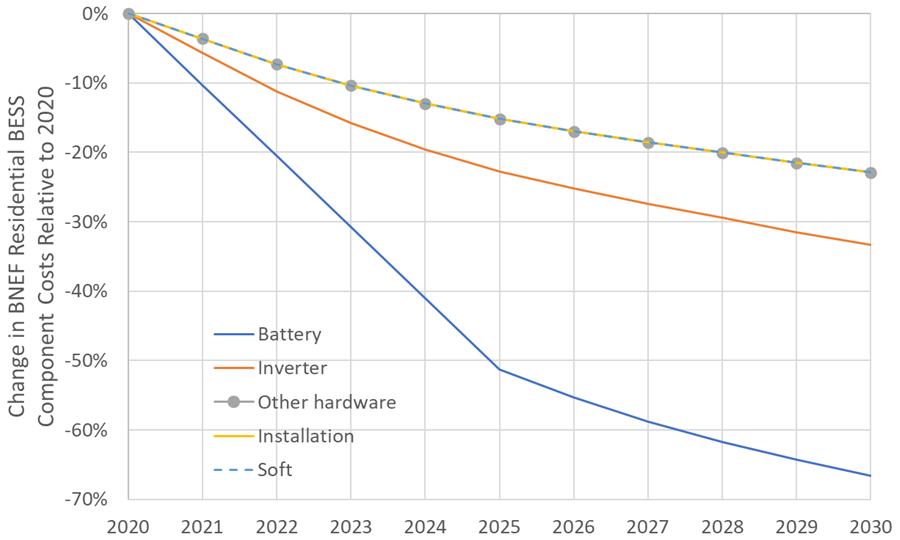
Figure 1. Changes in projected component costs for residential BESS
Data Source: (BNEF, 2019)
The methodology involves the following the steps to generate the Moderate Scenario future cost projections in detail:
- Record total and component cost results.
- Assign component costs to categories according to Table 1.
- Apply cost reductions from the BNEF projections (BNEF, 2020) to the corresponding component cost category for each BESS considered.
- BNEF projections only go to 2030. We assume residential BESS component costs decline by an additional 25% from 2030 to 2050, similar to the assumption used in the ATB utility-scale BESS cost projections in the 2022 ATB (Cole and Frazier, 2020) .
- Advanced Scenario and Conservative Scenario: Apply cost projections from the corresponding ATB utility-scale BESS scenario to all component costs.
- BESS cost (total $) = c 1 * P B + c 2 * E B + c 3
- Where P B = battery power capacity (kW) and E B = battery energy storage capacity ($/kWh), and c i = constants specific to each future year.
Capital Expenditures (CAPEX)
Definition: The bottom-up cost model documented by (Ramasamy et al., 2022) contains detailed cost bins for both solar only, battery-only, and combined systems. Though the battery pack is a significant cost portion of the cost of the battery system, it is a fraction of the cost of the system. This cost breakdown is different if the battery is part of a hybrid system with solar PV or a stand-alone system. The total costs by component for residential-scale stand-alone battery are demonstrated in Figure 2 for two different examples of systems.
Figure 2. Cost details for residential storage
Current Year (2022) : The Current Year (2022) cost estimate is taken from Ramasamy et al. (Ramasamy et al., 2022) and is currently in 2021 USD.
Within the ATB Data spreadsheet, costs are separated into energy and power cost estimates, which allows capital costs to be calculated for durations other than 4 hours according to the following equation:
$$\text{Total System Cost (\$/kW)} = \bigg[ \text{Battery Pack Cost (\$/kWh)} \times \text{Battery Energy Capacity (kWh)} \; +$$
$$ \text{Battery Power Capacity (kW)}\times \text{BOS Cost (\$/kW)} \; +$$
$$\text{Battery Power Constant (\$)} \bigg] / \; \text{Battery Power Capacity (kW)}$$
For more information on the power versus energy cost breakdown, see (Cole and Frazier, 2020) . For items included in CAPEX, see the table below.
Components of CAPEX
Future Projections : Future projections are based on the same literature review data that informed (Cole and Frazier, 2020) , who generally used the median of published cost estimates to develop a Mid Technology Cost Scenario and the minimum values to develop a Low Technology Cost Scenario. However, as the battery pack cost is anticipated to fall more quickly than the other cost components (which is similar to the recent history of PV system costs), the battery pack cost reduction is taken from BNEF (BNEF, 2020) and is reduced more quickly. This tends to make the longer-duration batteries (e.g., 10 hours) decrease more quickly and shorter-duration batteries (e.g., 2 hours) decrease less quickly into the future. All durations trend toward a common trajectory as battery pack costs decrease into the future.
Operation and Maintenance (O&M) Costs
Base Year : (Cole and Karmakar, 2023) assume no variable O&M (VOM) costs. All operating costs are instead represented using fixed O&M (FOM) costs. The fixed O&M costs include battery augmentation costs, which enables the system to operate at its rated capacity throughout its 15-year lifetime. FOM costs are estimated at 2.5% of the capital costs in $/kW. Items included in O&M are shown in the table below.
Components of O&M Costs
Future Years : In the 2023 ATB, the FOM costs and VOM costs remain constant at the values listed above for all scenarios.
Capacity Factor
The cost and performance of the battery systems are based on an assumption of approximately one cycle per day. Therefore, a 4-hour device has an expected capacity factor of 16.7% (4/24 = 0.167), and a 2-hour device has an expected capacity factor of 8.3% (2/24 = 0.083). Degradation is a function of this usage rate of the model and systems might need to be replaced at some point during the analysis period. We use the capacity factor for a 4-hour device as the default value for ATB due to the expectation that 4-hour durations are more typical in the utility-scale market.
Round-Trip Efficiency
Round-trip efficiency is the ratio of useful energy output to useful energy input. (Cole and Karmakar, 2023) identified 85% as a representative round-trip efficiency, and the 2023 ATB adopts this value.
The following references are specific to this page; for all references in this ATB, see References .
Augustine, Chad, and Nate Blair. “Energy Storage Futures Study: Storage Technology Modeling Input Data Report.” Golden, CO: National Renewable Energy Laboratory, 2021. https://dx.doi.org/10.2172/1785959 .
Ramasamy, Vignesh, Jarett Zuboy, Eric O’Shaughnessy, David Feldman, Jal Desai, Michael Woodhouse, Paul Basore, and Robert Margolis. “U.S. Solar Photovoltaic System and Energy Storage Cost Benchmarks, With Minimum Sustainable Price Analysis: Q1 2022.” Golden, CO: National Renewable Energy Laboratory, 2022. https://doi.org/10.2172/1891204 .
BNEF. “Energy Storage System Costs Survey 2021.” New York, NY: BloombergNEF, 2021.
BNEF. “Energy Storage System Costs Survey 2020.” Bloomberg New Energy Finance, December 16, 2020.
Mann, Margaret, Vicky Putsche, and Benjamin Sharger. “Grid Energy Storage: Supply Chain Deep Dive Assessment.” Washington, D.C.: U.S. Department of Energy, February 24, 2022. https://www.energy.gov/policy/securing-americas-clean-energy-supply-chain .
BNEF. “Energy Storage System Costs Survey 2019.” BloombergNEF, October 14, 2019.
Cole, Wesley, and Will A. Frazier. “Cost Projections for Utility-Scale Battery Storage: 2020 Update.” Golden, CO: National Renewable Energy Laboratory, 2020. https://doi.org/10.2172/1665769 .
Cole, Wesley, and Akash Karmakar. “Cost Projections for Utility-Scale Battery Storage: 2023 Update.” Golden, CO: National Renewable Energy Laboratory, 2023. https://www.nrel.gov/docs/fy23osti/85332.pdf .

IMAGES
COMMENTS
Round-Trip Efficiency. Round-trip efficiency is the ratio of useful energy output to useful energy input. (Mongird et al., 2020) identified 86% as a representative round-trip efficiency, and the 2022 ATB adopts this value. In the same report, testing showed 83-87%, literature range of 77-98%, and a projected increase to 88% in 2030.
Some battery technologies can have round-trip efficiencies ranging from 75% to 90%. 2. Storage duration: Some technologies may experience leakage or energy loss over long-term storage, which can affect round-trip efficiency. It is important to consider the specific characteristics and limitations of the storage technology when evaluating its ...
fully charged. The state of charge influences a battery's ability to provide energy or ancillary services to the grid at any given time. • Round-trip efficiency, measured as a percentage, is a ratio of the energy charged to the battery to the energy discharged from the battery. It can represent the total DC-DC or AC-AC efficiency of
The higher the round-trip efficiency, the less energy is lost in the storage process. According to data from the U.S. Energy Information Administration (EIA), in 2019, the U.S. utility-scale battery fleet operated with an average monthly round-trip efficiency of 82%, and pumped-storage facilities operated with an average monthly round-trip ...
Round-Trip Efficiency. Round-trip efficiency is the ratio of useful energy output to useful energy input. (Mongird et al., 2020) identified 86% as a representative round-trip efficiency, and the 2021 ATB adopts this value. References . The following references are specific to this page; for all references in this ATB, see References.
The battery storage technologies do not calculate LCOE or LCOS, so do not use financial assumptions. ... Round-Trip Efficiency. Round-trip efficiency is the ratio of useful energy output to useful energy input. Based on Cole et al. (Cole and Karmakar, 2023), the 2023 ATB assumes a round-trip efficiency of 85%.
RTE varies among different types of storage batteries. For older battery systems, 80% round trip efficiency would have been considered a good standard. Some evidence suggests the typical lithium-ion battery - a popular choice for modern battery energy storage systems and electric vehicles - has round trip efficiency of around 83%. GivEnergy ...
The objective of the current study is to investigate and analyse the lithium-ion battery round-trip efficiency. A mathematical model has been established to calculate the battery's coulombic efficiency over a charge-discharge cycle. A comprehensive analysis has been carried out on the developed model to evaluate and compare different battery ...
health of field installations of grid-connected battery energy storage systems (BESS) is described. Performance and health metrics captured in the procedures are: ound-trip efficiency, r standby losses, esponse time/accuracy, and r seable energy/ u state of harge at different discharge/charge c over the rates system's lifetime.
• Th round-trip efficiency of batteries ranges between 70% for nickel/metal hydride and more than 90% for lithium-ion batteries. • This is the ratio between electric energy out during discharging to the electric energy in during charging. The battery efficiency can change on the charging and discharging rates because of the dependency
To begin with, battery round trip efficiency calculation involves determining the ratio of the energy outputted by the battery to the energy inputted into it during charging. This calculation is crucial for understanding how much energy is lost in the process of charging and discharging a battery. These energy losses typically occur due to ...
The battery round-trip efficiency is the round trip DC-to-storage-to-DC energy efficiency of the storage bank, or the fraction of energy put into the storage that can be retrieved. Typically it is about 80%. HOMER assumes the storage charge efficiency and the storage discharge efficiency are both equal to the square root of the round-trip ...
Round-trip efficiency is a measure of the amount of energy put into a system compared to the amount dispatched, and is expressed as a percentage. A system with a high RTE (75%+) is able to ...
The round trip efficiency of a battery storage system can be calculated using the following formula: Round Trip Efficiency = (Energy Out / Energy In) * 100% Where: - Energy Out is the amount of energy discharged from the battery - Energy In is the amount of energy charged into the battery.
Round-trip efficiency is the ratio of energy charged to the battery to the energy discharged from the battery and is measured as a percentage. It can represent the battery system's total AC-AC or DC-DC efficiency, including losses from self-discharge and other electrical losses. In addition to the above battery characteristics, BESS have other ...
This data-file derives the 'net round trip efficiency' of nine different battery solutions for storing energy. Rough costs are also estimated. Net round trip efficiency is calculated as the energy efficiency of the battery (kWh recovered per kWh fed in) divided by the energy efficiency of the displaced energy source.. We see great potential in "good batteries", for example ...
Providing the definition and how to calculate a Battery Roundtrip Efficiency
Round-Trip Efficiency. Round-trip efficiency is the ratio of useful energy output to useful energy input. (Mongird et al., 2020) identified 86% as a representative round-trip efficiency, and the 2022 ATB adopts this value. In the same report, testing showed 83-87%, literature range of 77-98%, and a projected increase to 88% in 2030.
The battery efficiency depends on the source of charging: we assume 85% round-trip efficiency when charging from the grid and 87% efficiency when charging from the coupled PV (because of avoided AC/DC conversions in the latter case) (Schleifer et al., 2022). In the figure below, RTE (round-trip efficiency) refers to the efficiency when charging ...
The 2021 ATB represents cost and performance for battery storage with two representative systems: a 3 kW / 6 kWh (2 hour) system and a 5 kW / 20 kWh (4 hour) system. It represents lithium-ion batteries only at this time. There are a variety of other commercial and emerging energy storage technologies; as costs are well characterized, they will ...
Round-trip Efficiency: It is the percentage of energy delivered by the BESS during discharging when compared to the energy supplied to the BESS during charging. Flow battery technology has lower round-trip efficiency compared to Lithium-ion batteries. It means that higher energy is wasted (during charge-discharge) when flow batteries are ...
Look at battery history in VictronConnect or in advanced on VRM to get the totals. I think you'll then be happier ;) The dashboard of VRM doesn't add everything up, it doesn't currently show how many kWh from a generator have charged the batteries for example, but the accurate totals are shown in battery history.
How to calculate this energy amount? The Energy Throughput is equal to Nominal Capacity x Round-trip Efficiency x Depth of Discharge x Battery Cycle Life. For example, A Fortress LFP-10 has a normal capacity of 10.2 kWh and an exceptional roundtrip efficiency of 98%. We guarantee 6000 cycles at 80% of Depth of Discharge (DoD).
Most energy storage systems that use flow-batteries have round trip efficiencies of 75 percent or more, meaning that if you charge the battery with 100 kWh, you would be able to discharge 75 kWh of electricity from the battery. By integrating round-trip efficiency into the LCOE calculation these efficiency losses are accounted for, and you can ...
The battery storage technologies do not calculate levelized cost of energy (LCOE) or levelized cost of storage (LCOS) and so do not use financial assumptions. Therefore, all parameters are the same for the research and development (R&D) and Markets & Policies Financials cases. ... Round-Trip Efficiency. Round-trip efficiency is the ratio of ...
The battery storage technologies do not calculate LCOE or LCOS, so do not use financial assumptions. ... Round-Trip Efficiency. Round-trip efficiency is the ratio of useful energy output to useful energy input. (Cole and Karmakar, 2023) identified 85% as a representative round-trip efficiency, and the 2023 ATB adopts this value.